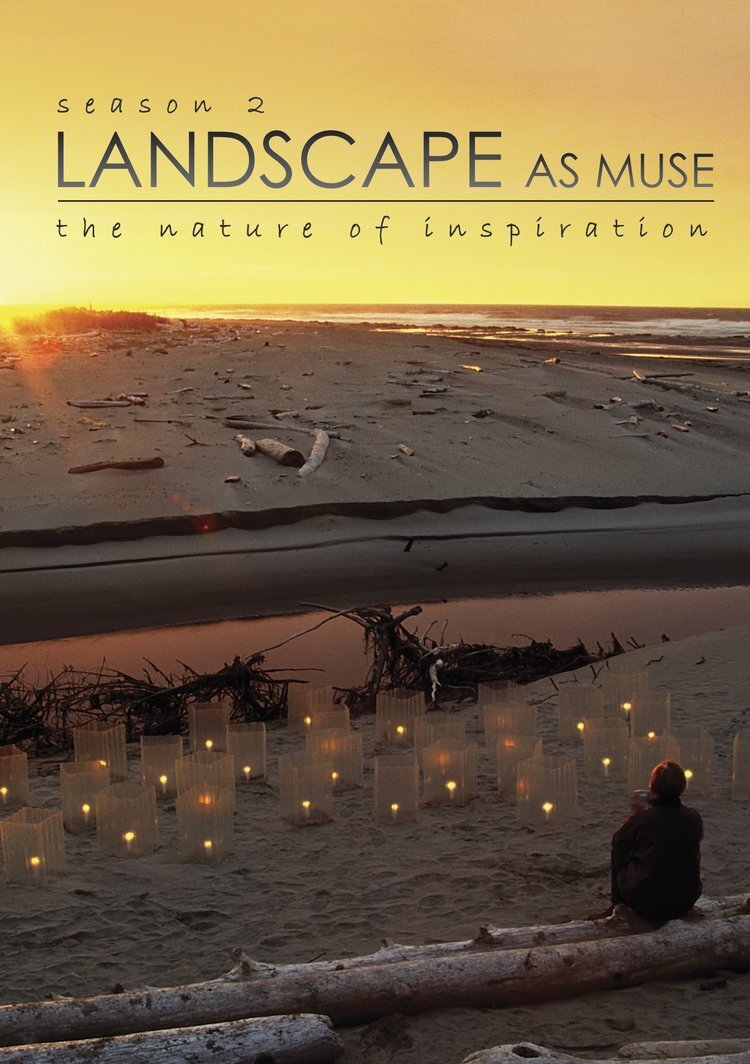Tom Willock
dark-room based selenium toned silver emulsion black & white photographs - scroll down for category pricing levels and sizes…
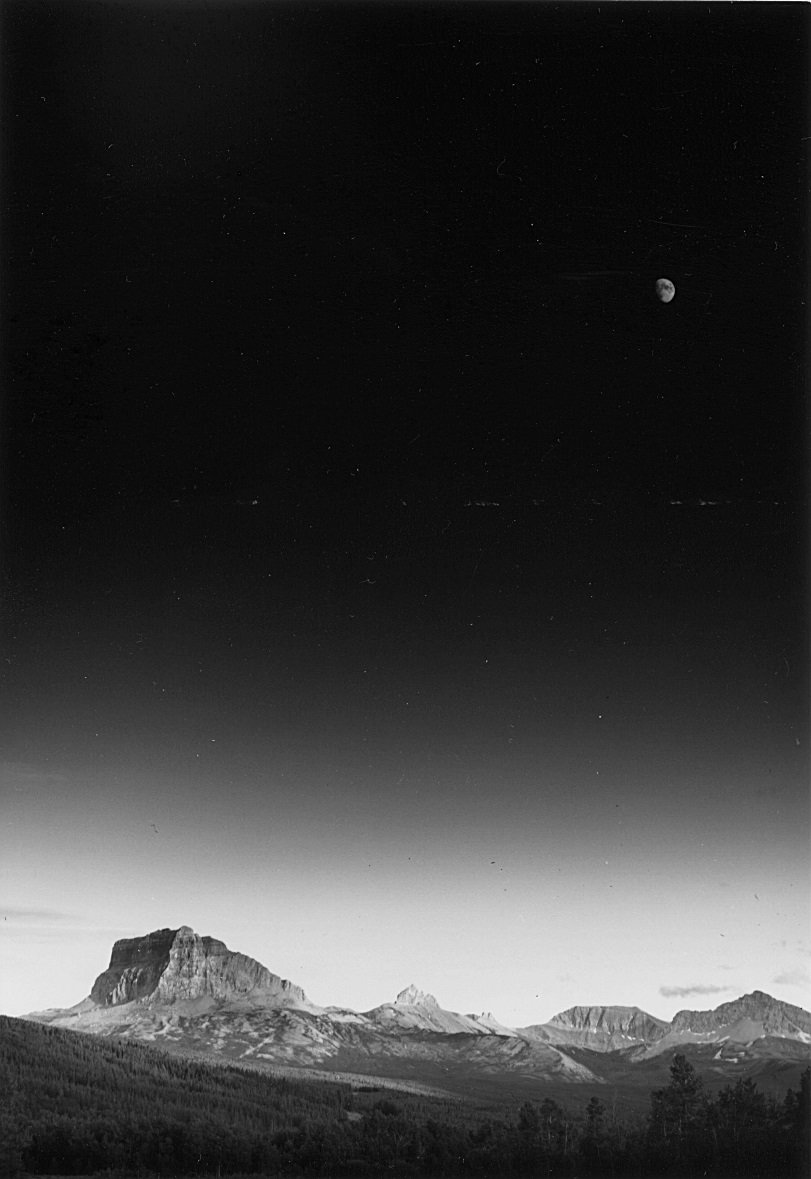
Chief Mountain From Belly River (cat#1), 1984, contact print, dark-room based selenium toned silver gelatin black & white photography, 7x5 inches (18 x 13 cm), framed, ($1100 Cdn, category G).
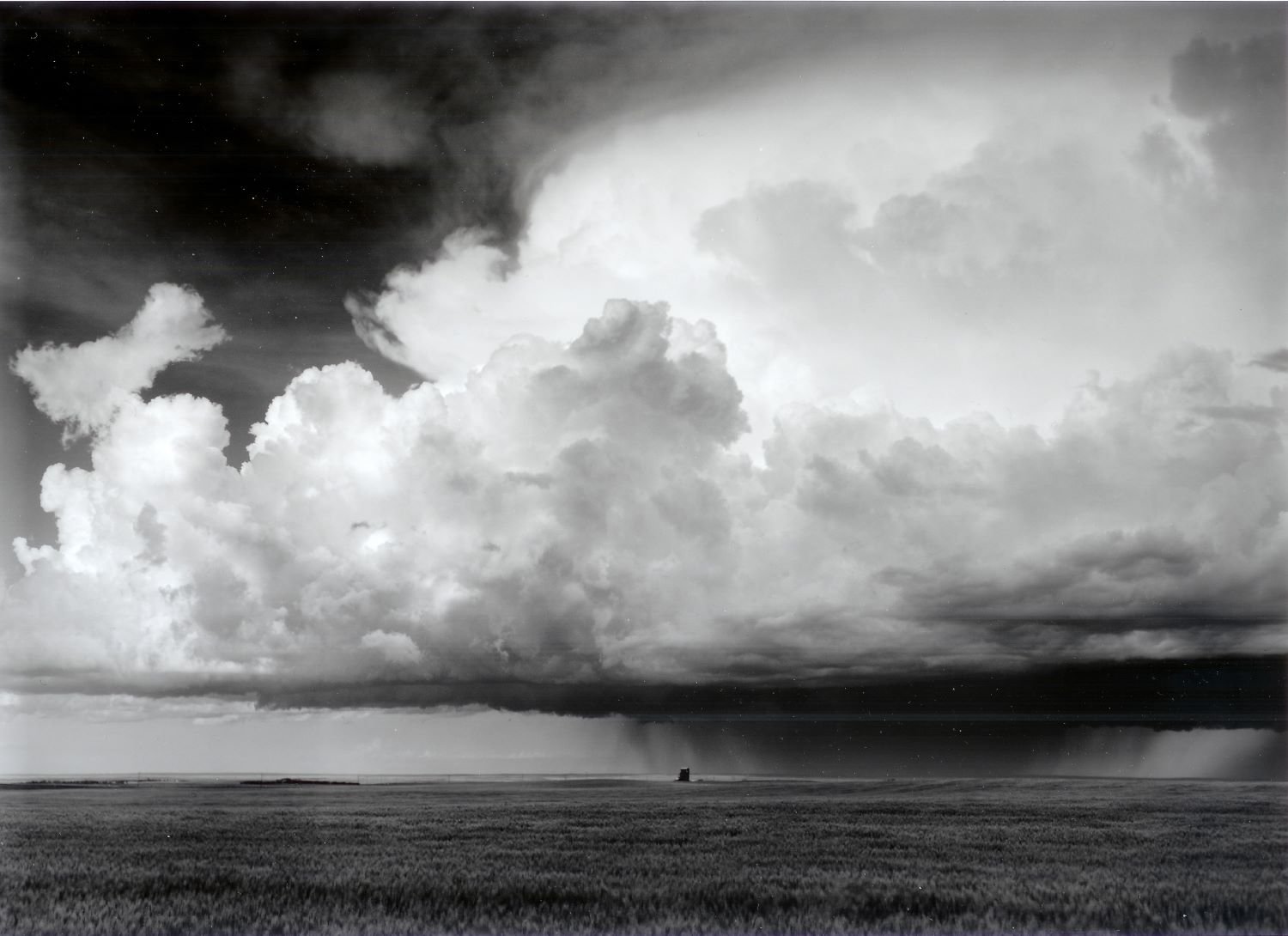
Sleepy Hollow, Alberta (cat#2), 1992, dark-room based selenium toned silver emulsion black & white photograph, 20x24 inches (51 x 61 cm), framed, ($3200 Cdn, category F); 11 x 14 inches (28 x 35.5 cm) ($825 Cdn, category D); 8 x 10 inches (20.5 x 25.5 cm) ($625 Cdn, category C).
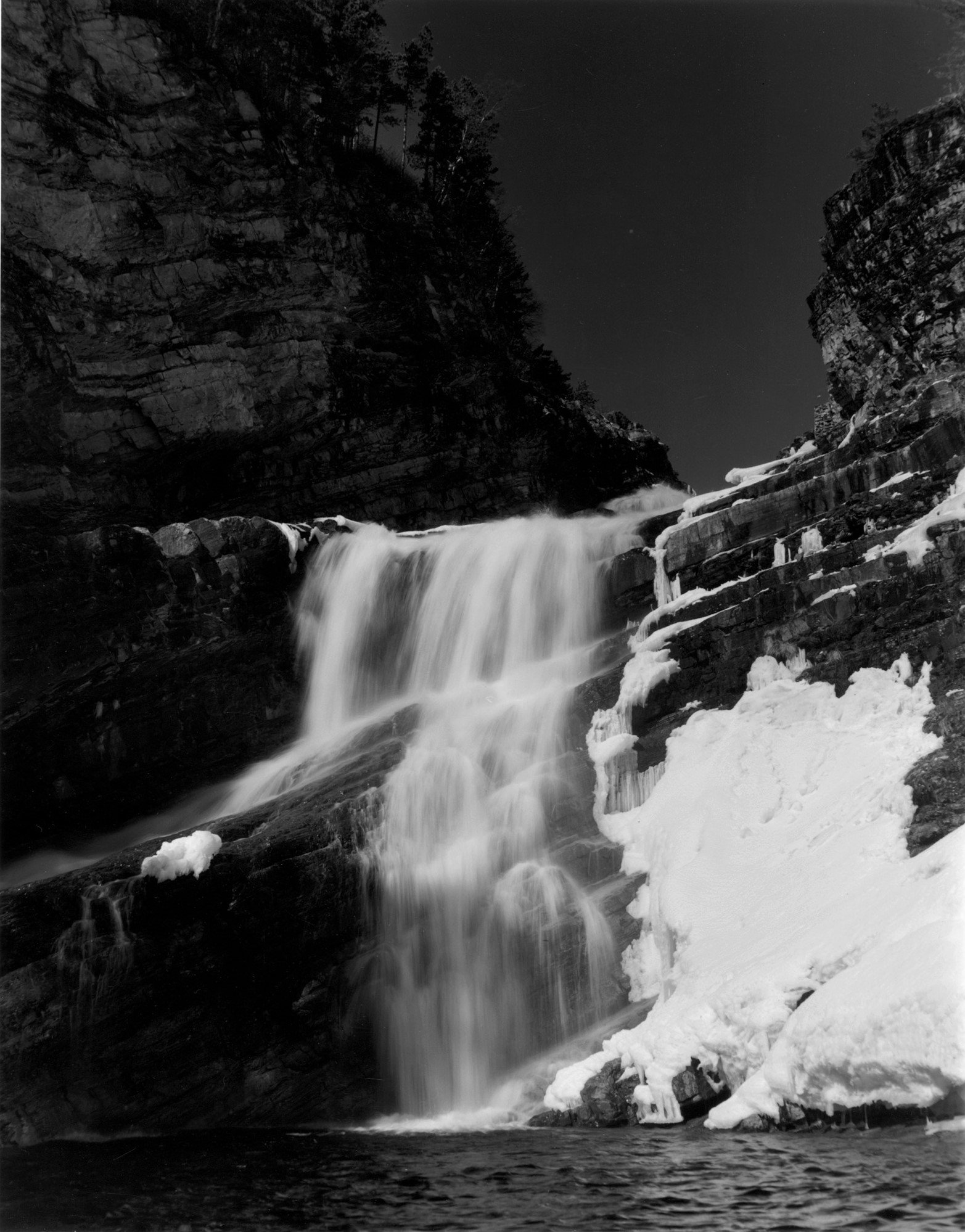
Cameron Falls, Waterton (cat#4), 1972, dark-room based selenium toned silver emulsion black & white photograph, 10 x 8 inches (25.5 x 20.5 cm), ($625 Cdn, category C).
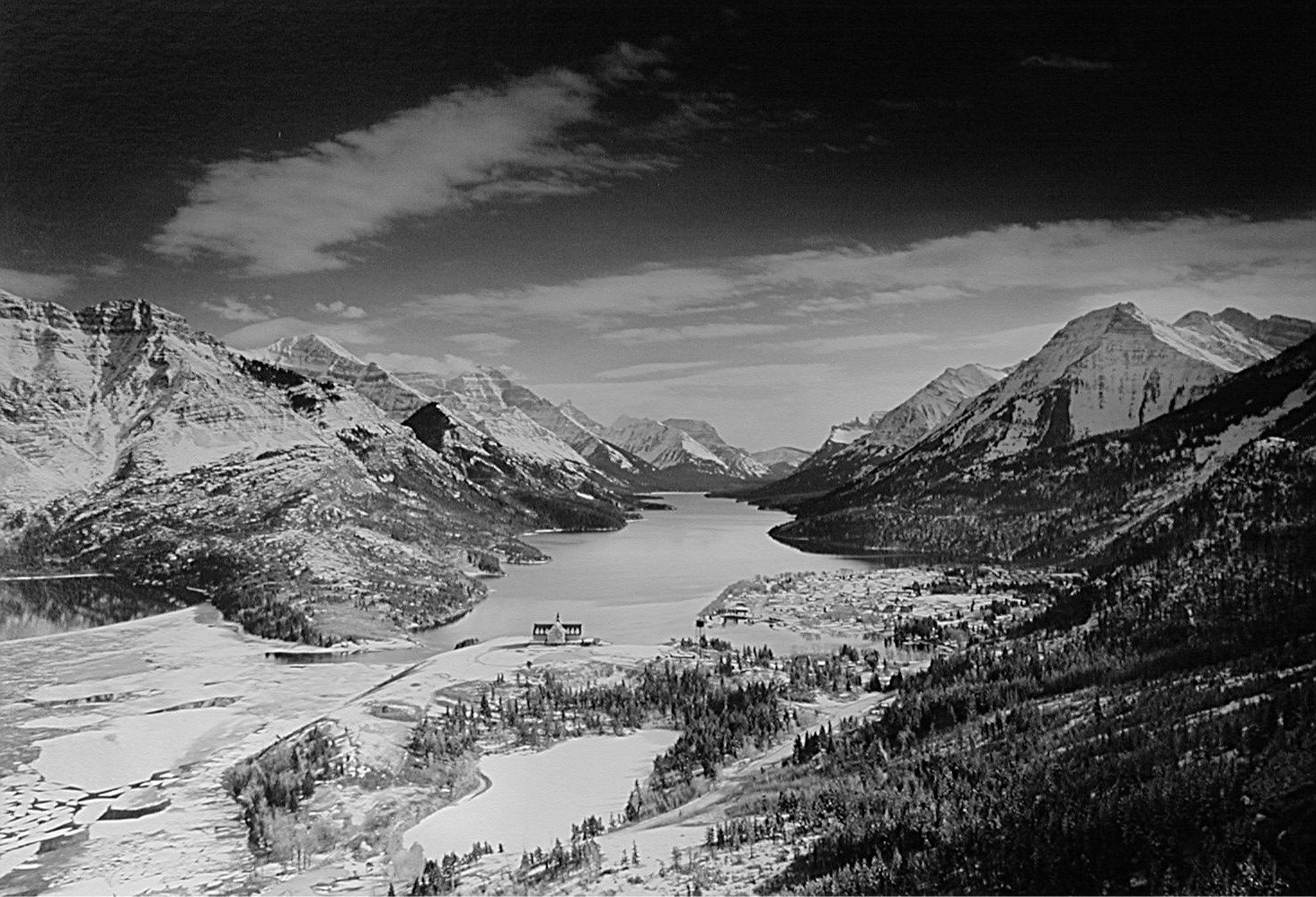
Upper Waterton Valley (cat#5), 2000, dark-room based selenium toned silver emulsion black & white photograph, framed, 16 x 20 inches (40.5 x 51 cm), ($2200 Cdn, category E); 11x14 inches (27 x 35.5 cm), ($825 Cdn, category D); 8 x 10 inches (20 x 25.5 cm) ($625 Cdn, category C).
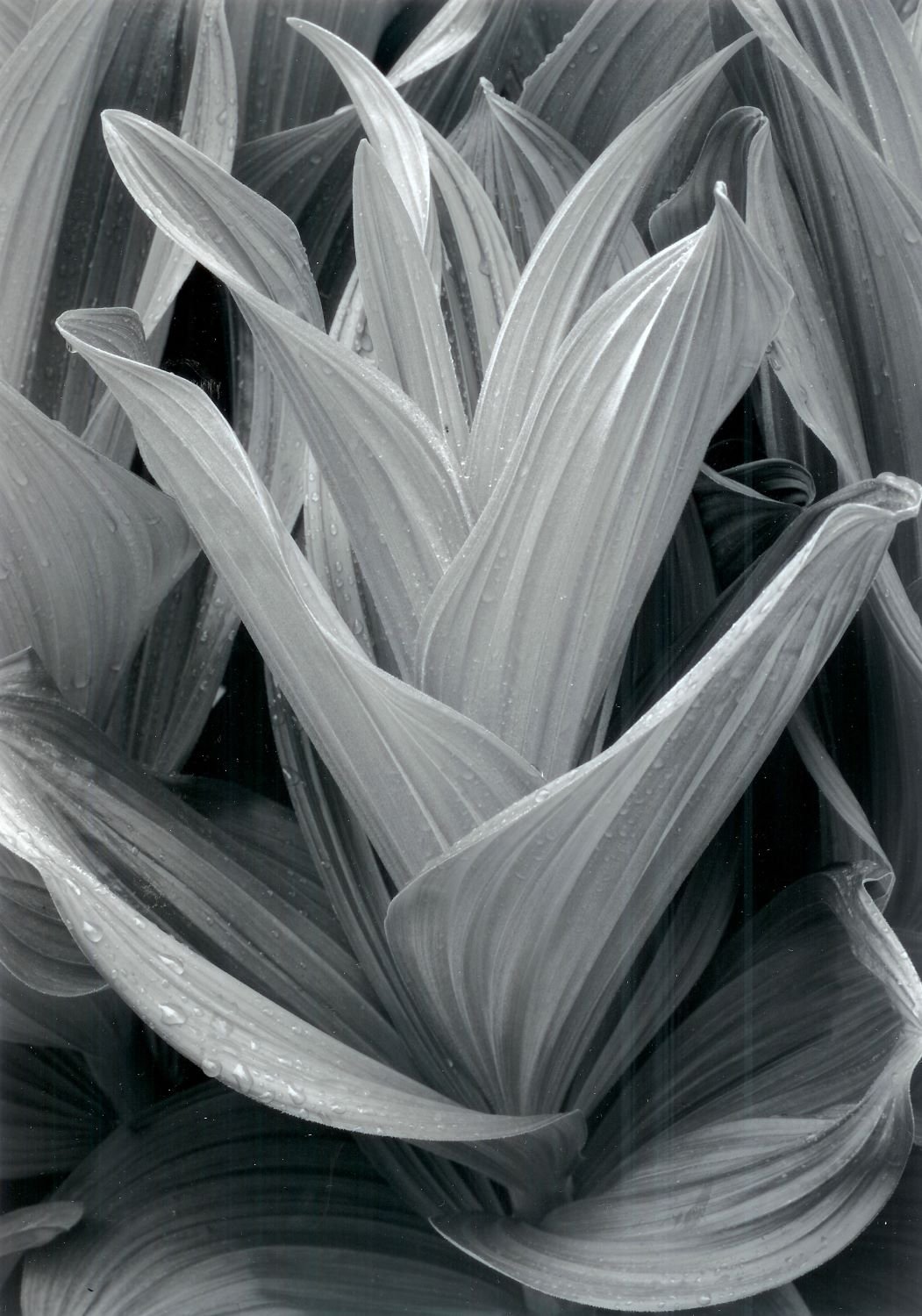
False Hellebore (cat#7), 2000, dark-room based selenium toned silver emulsion black & white photograph, framed, 20 x 16 inches (51x40.5 cm), ($2200 Cdn, category E).
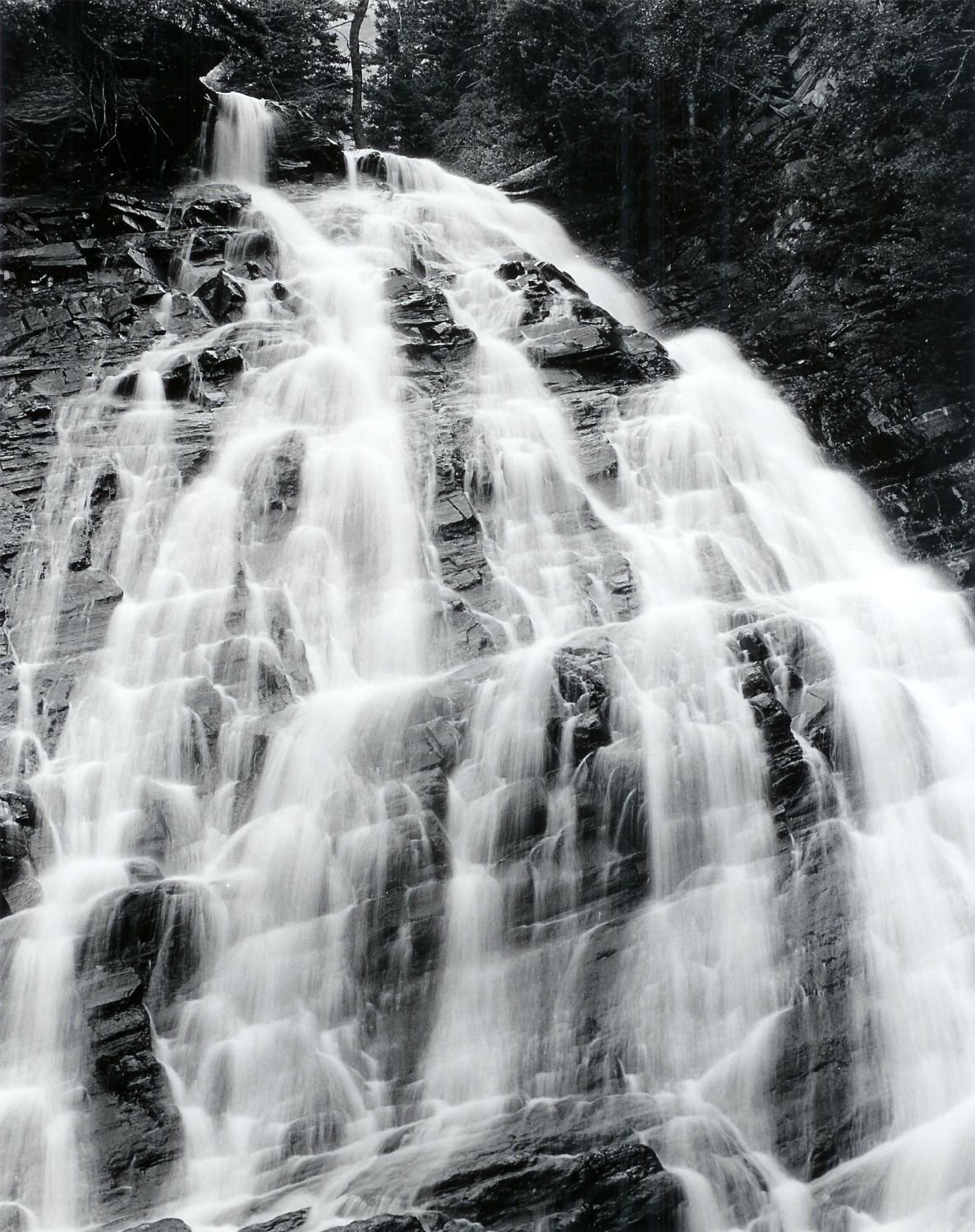
Lower Bertha Falls (cat#8), 1993, editioned, dark-room based selenium toned silver emulsion black & white photograph, framed, 20 x 16 inches (51x40.5 cm), ($2200 Cdn, category E).

Pica Pica (Magpies) (cat#9), 1970, dark-room based selenium toned silver emulsion black & white photograph, framed, 11 x 14 inches (28 x 35.5 cm), ($825 Cdn, category D) and 16x20 inches (40.5 x 51 cm), ($2200 Cdn, category E).
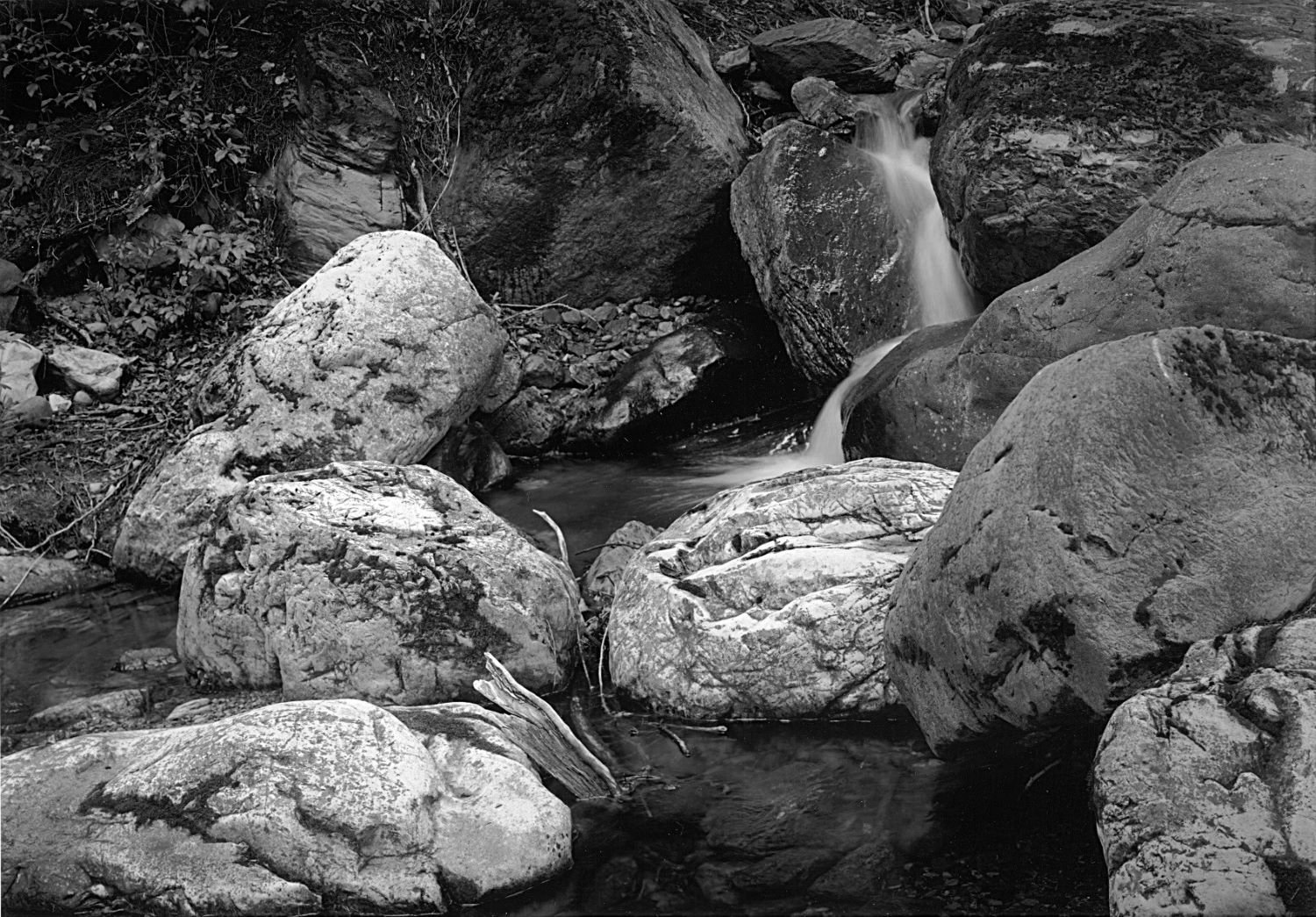
Coppermine Creek, Study #3, Waterton (cat#10), 2000, dark-room based selenium toned silver emulsion black & white photograph, framed, 8 x 10 inches (20.5 x 25.5 cm), ($625 Cdn, category C) and 16x20 inches (40.5 x 51 cm), ($2200 Cdn, category E).
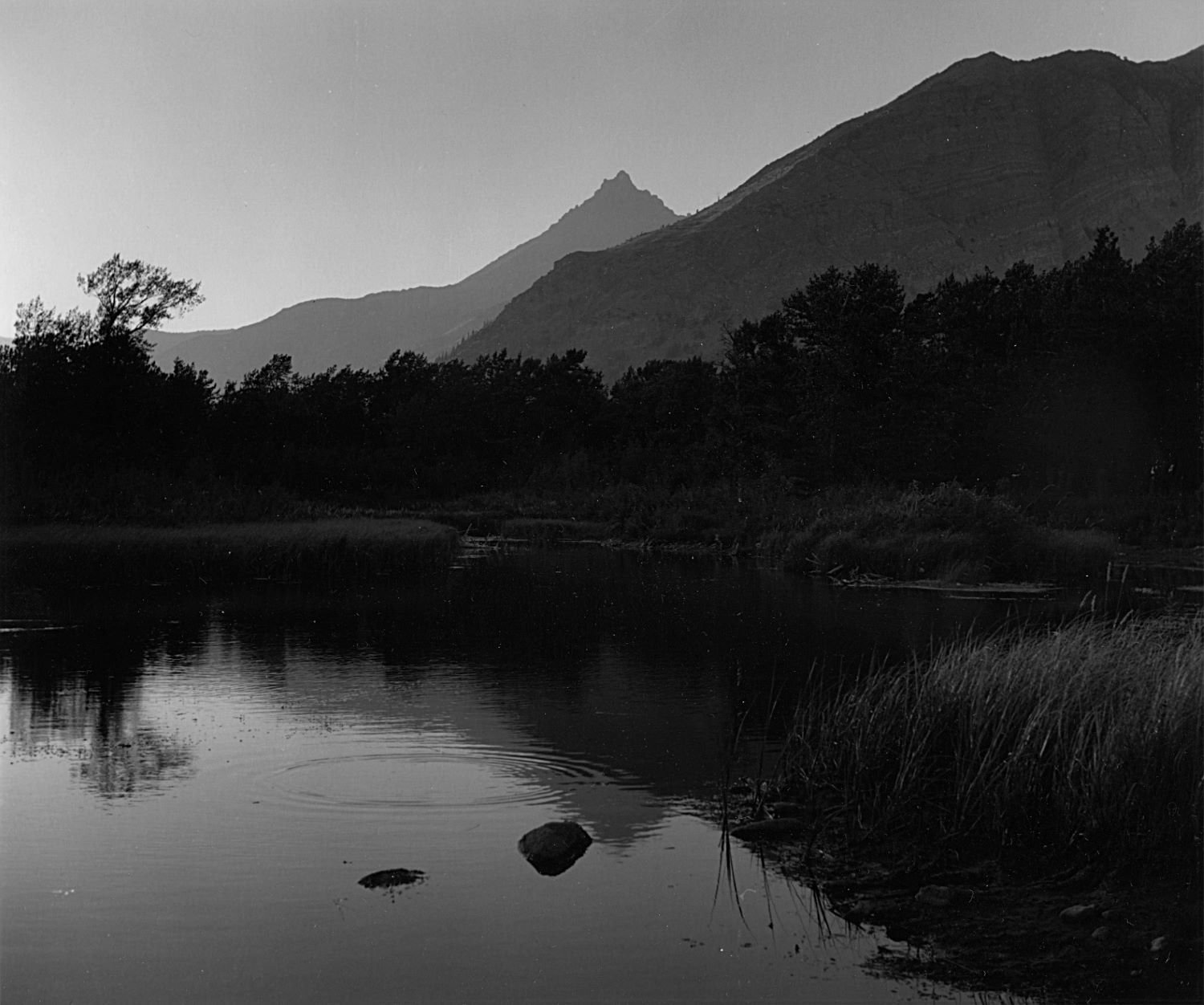
Beaver Pond, Blakiston Valley, Waterton, 1980, (cat.#13), dark-room based selenium toned silver emulsion black & white photograph, framed, 11 x 14 inches (28 x 35.5 cm), ($825 Cdn, category D).

Fox Pup #1 (cat#14), 1972, dark-room based selenium toned silver emulsion black & white photograph, framed, 7x5 inches (18 x 13 cm) ($400 Cdn, category B); 10 x 8 inches (25.5 x 20.5 cm), ($625 Cdn, category C); 20 x 16 inches (51 x 40.5 cm), $2200 Cdn, category E); 24x20 inches (61 x 51 cm) ($3200 Cdn, category F).
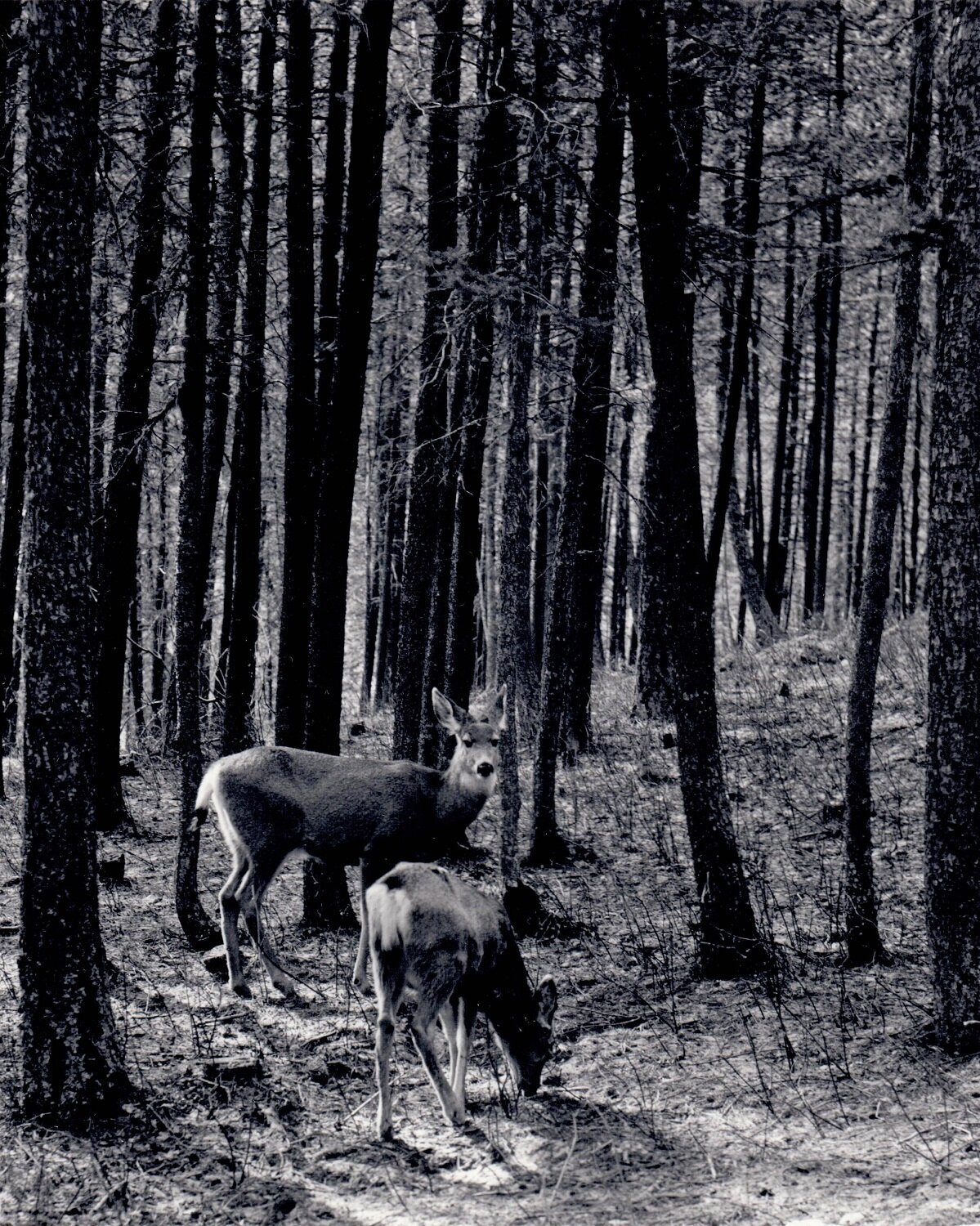
Doe and Fawn (cat#16), 1967, dark-room based selenium toned silver emulsion black & white photograph, framed, 10 x 8 inches (25.5 x 20.5 cm), ($625 Cdn, category C).
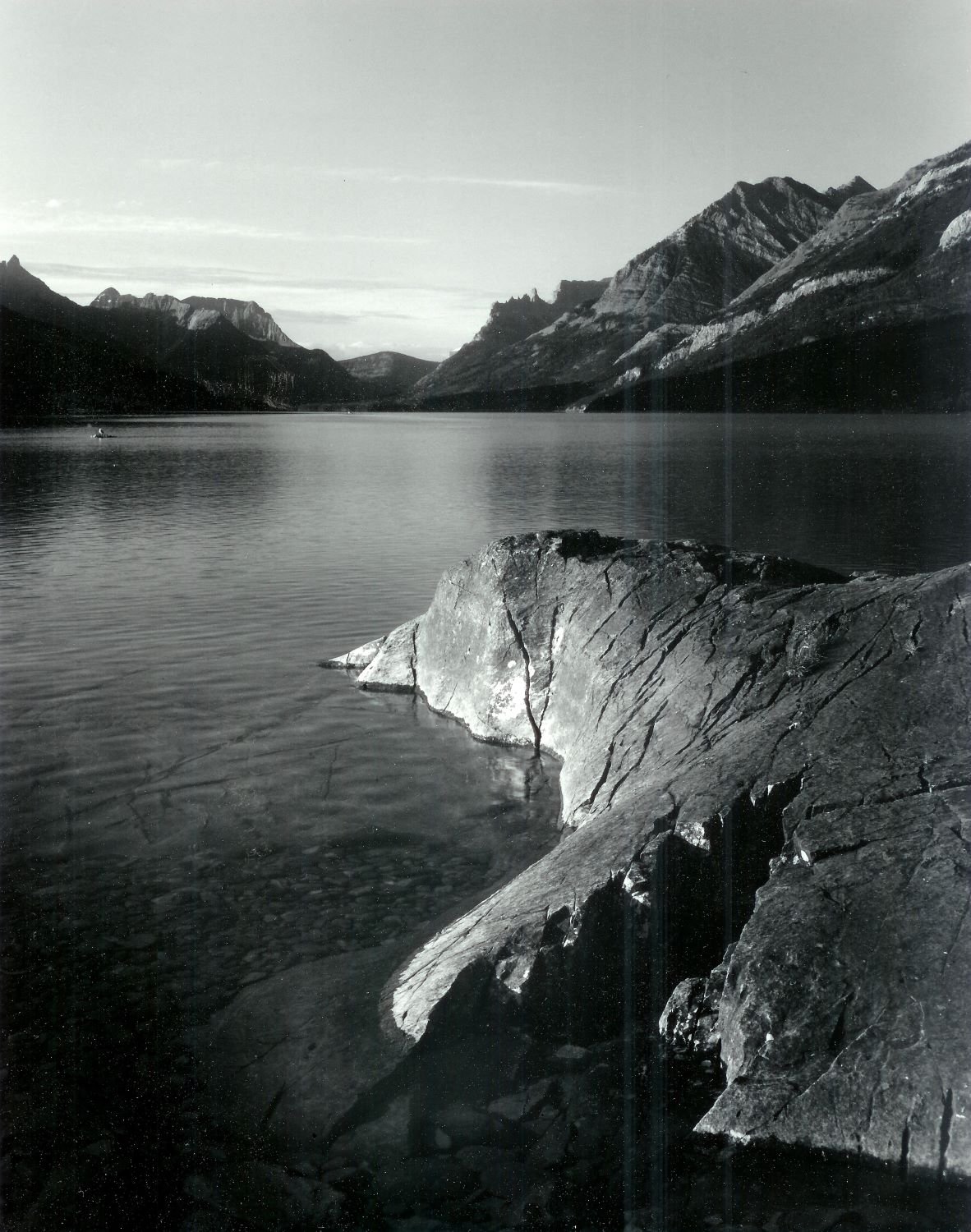
Waterton Seagull On The Rocks (cat#17), 1984, dark-room based selenium toned silver emulsion black & white photograph, 10 x 8 inches (25.5 x 20.5 cm), framed, ($625 Cdn, category C).

Leaves and Pool, Coppermine Creek, Waterton (cat#18), 1983, dark-room based selenium toned silver emulsion black & white photograph, framed, 20 x 16 inches (category E); also part of Elements Of Wilderness Portfolio (category I).
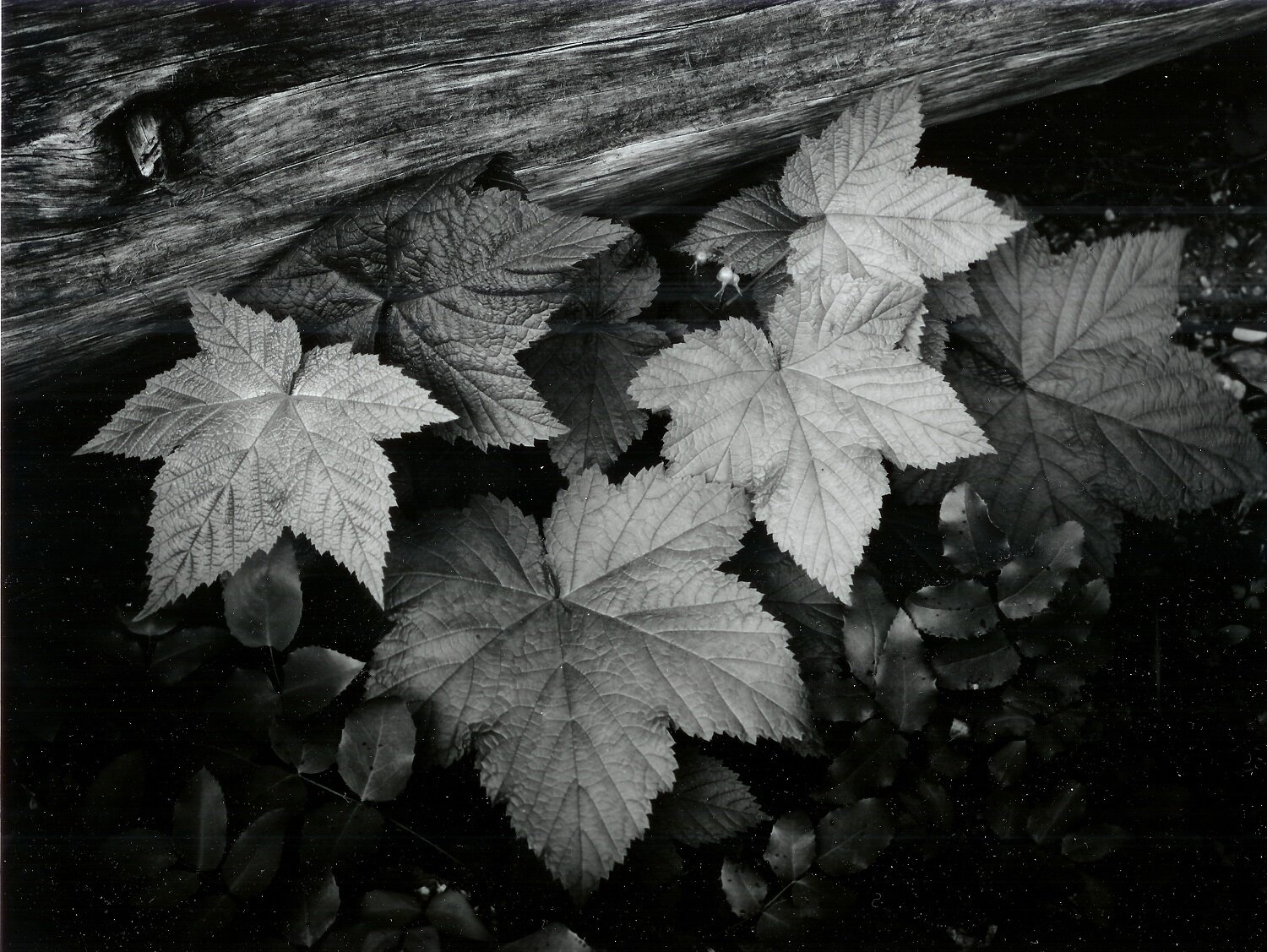
Thimbleberry Leaves, Hell Roaring Creek, Waterton (cat#23), 1984, dark-room based selenium toned silver emulsion black & white photograph, framed, 16 x 20 inches (40.5 x 51 cm), ($2200 Cdn, category E); 11 x 14 inches (28 x 35.5 cm), ($825 Cdn, category D); part of Elements Of Wilderness Portfolio.
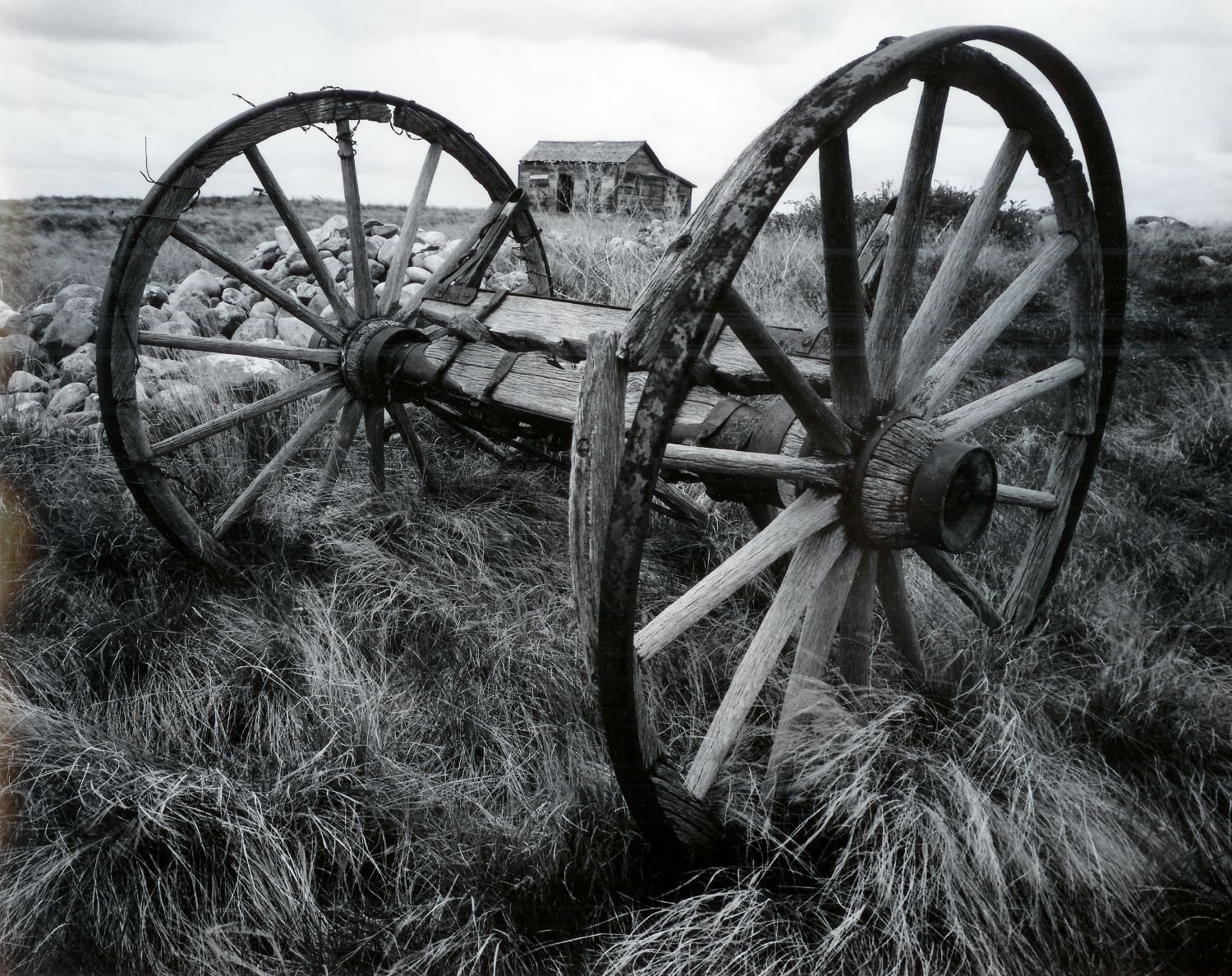
Wagon Wheels, Abandoned Farmstead, Milk River Valley (cat#26), 1971, dark-room based selenium toned silver emulsion black & white photograph, 8x10 inches (20.5 x 25.5 cm), framed, ($625 Cdn, category C).

Narrows, Cameron Creek Near Oil City (cat#27), 1984, dark-room based selenium toned silver emulsion black & white photograph, framed, 20 x 24 inches (51x61 cm), ($3200 Cdn, category F); 16 x 20 inches (40.5 x 51 cm), ($2200 Cdn, category E); 11 x 14 inches (28 x 35.5 cm), ($825 Cdn, category D); part of Elements Of Wilderness Portfolio.
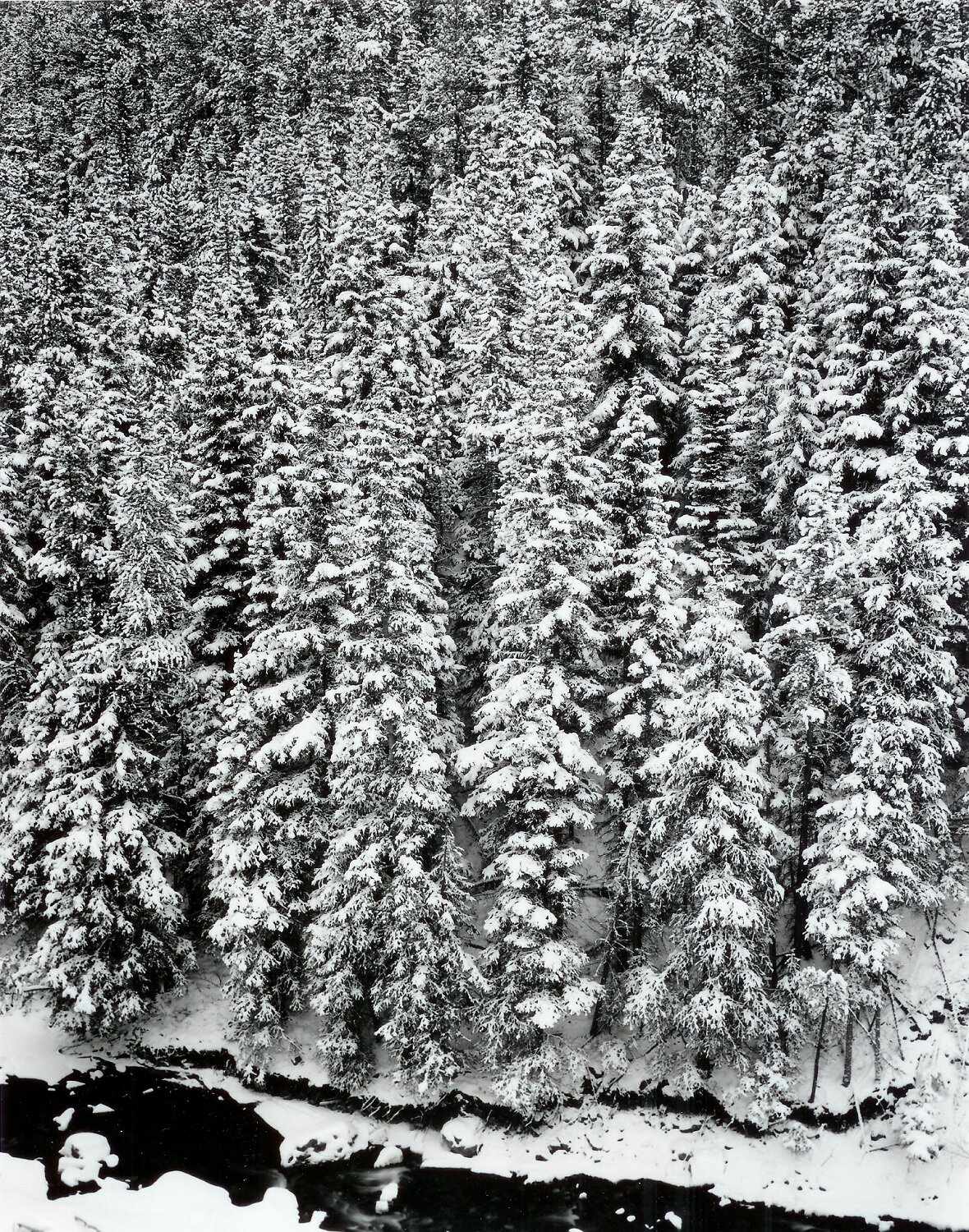
Forest In Winter, Buchanan Ridge, Waterton (cat#28), 1994, editioned, dark-room based selenium toned silver emulsion black & white photograph, framed, 24x20 inches (61x51 cm), ($3200 Cdn, category F); 20 x 16 inches (51x40.5 cm), ($2200 Cdn, category E).
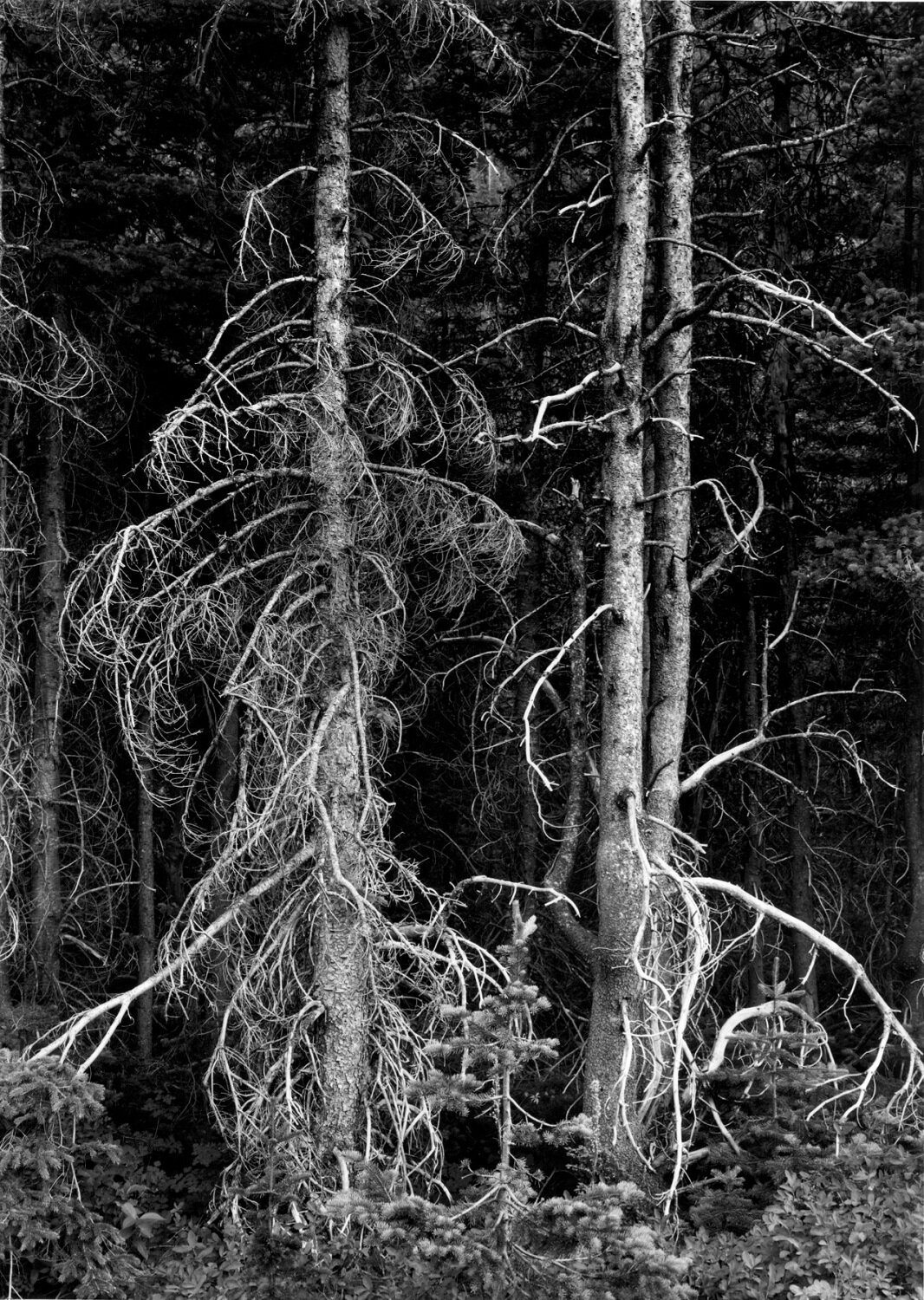
Spires, Mount Carthew, Waterton (cat#30), 1984, dark-room based selenium toned silver emulsion black & white photograph, framed, 20 x 24 inches (51x61 cm), ($3200 Cdn, category F); 20 x 16 inches (category E); also part of Elements Of Wilderness Portfolio (category I).
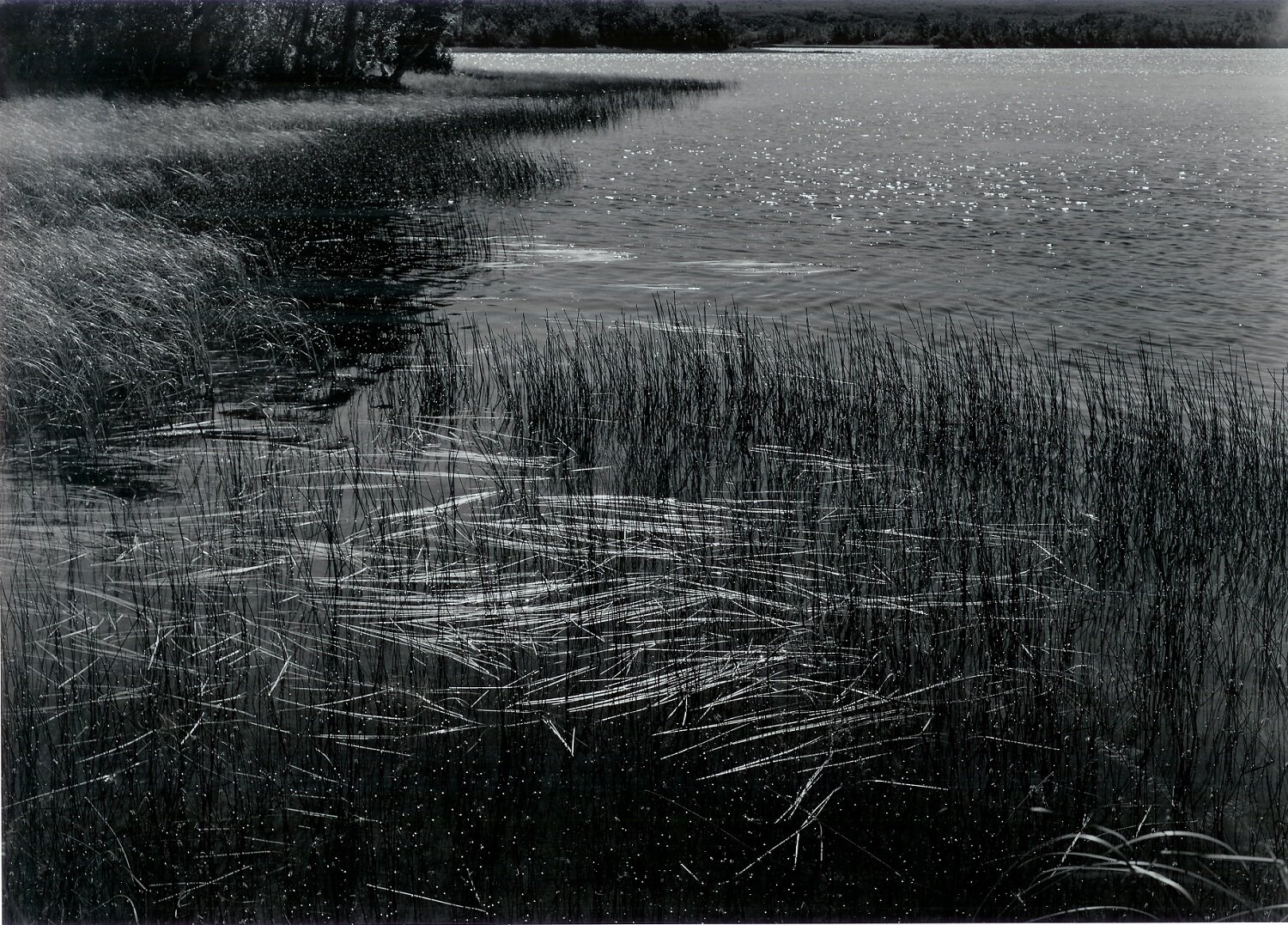
Marsh Grass, Maskinonge Lake At Sunrise, Waterton (cat#32), 1984, dark-room based selenium toned silver emulsion black & white photograph, framed, 11 x 14 inches (28 x 35.5 cm), ($825 Cdn, category D); also part of Elements Of Wilderness Portfolio.
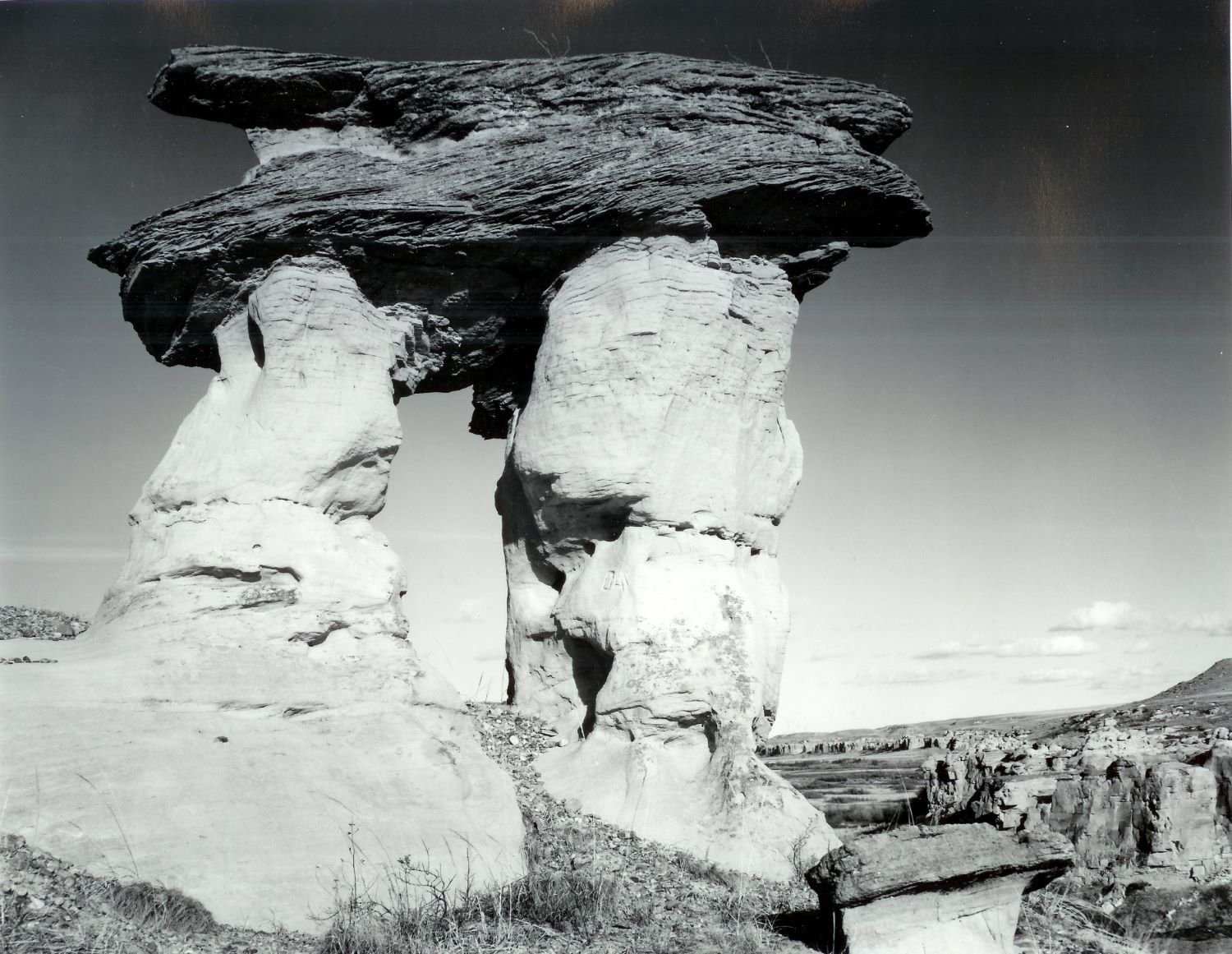
Sandstone Formation (Milk River Valley #1 - Sandstone Arch) (cat#36), 1971, dark-room based selenium toned silver gelatin black & white photography, framed, 20 x 24 inches (51x61 cm), ($3200 Cdn, category F) and 8x10 inches (20.5 x 25.5 cm), ($625 Cdn, category C).
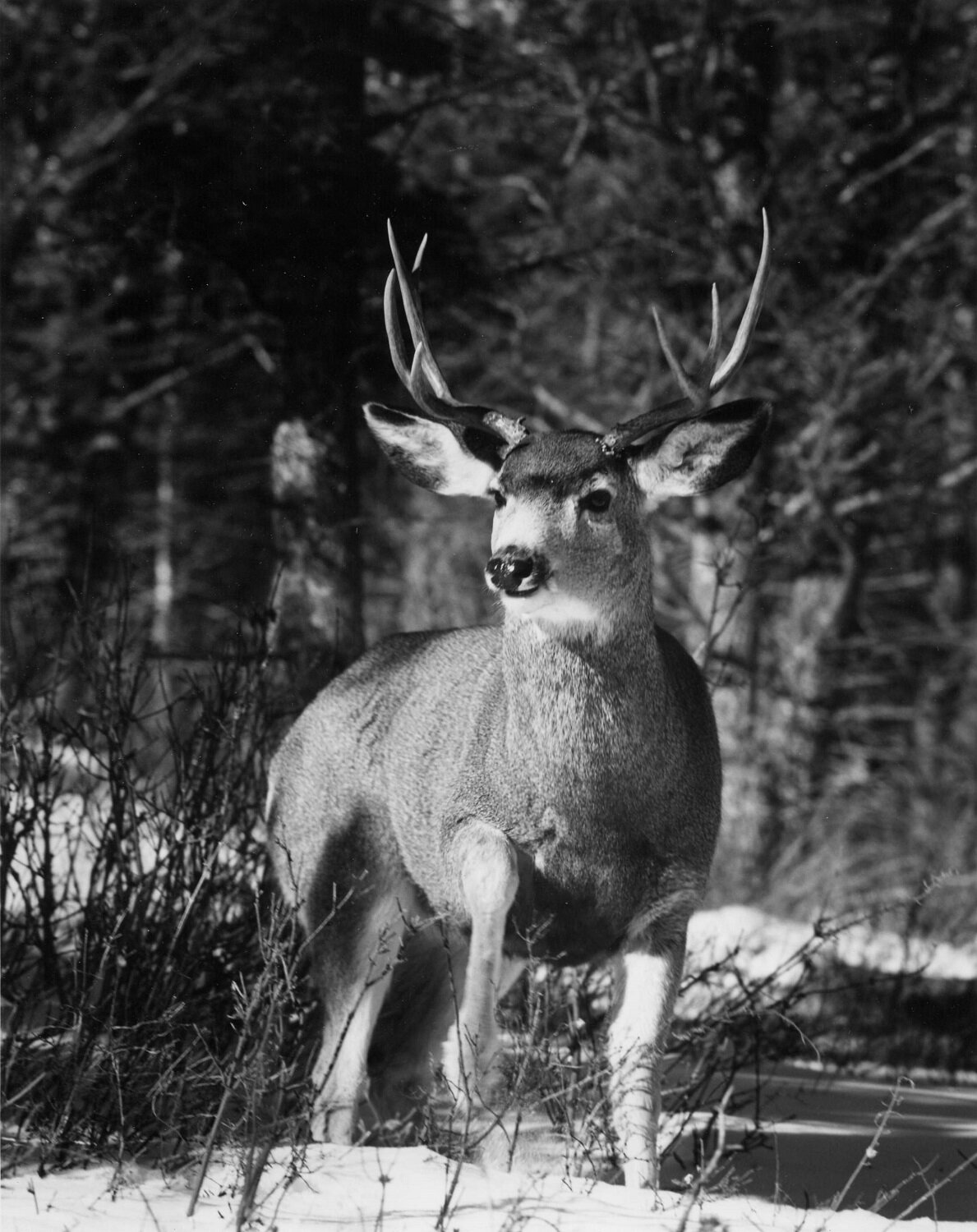
Mule Deer #1 (cat#37), 1973, dark-room based selenium toned silver emulsion black & white photograph, 20 x 16 inches (51 x 40.5 cm), ($2200 Cdn, category E); 14x11 inches (35.5 x 28 cm), ($825 Cdn, category D); and 10 x 8 inches (25.5 x 20.5 cm) ($625 Cdn, category C).
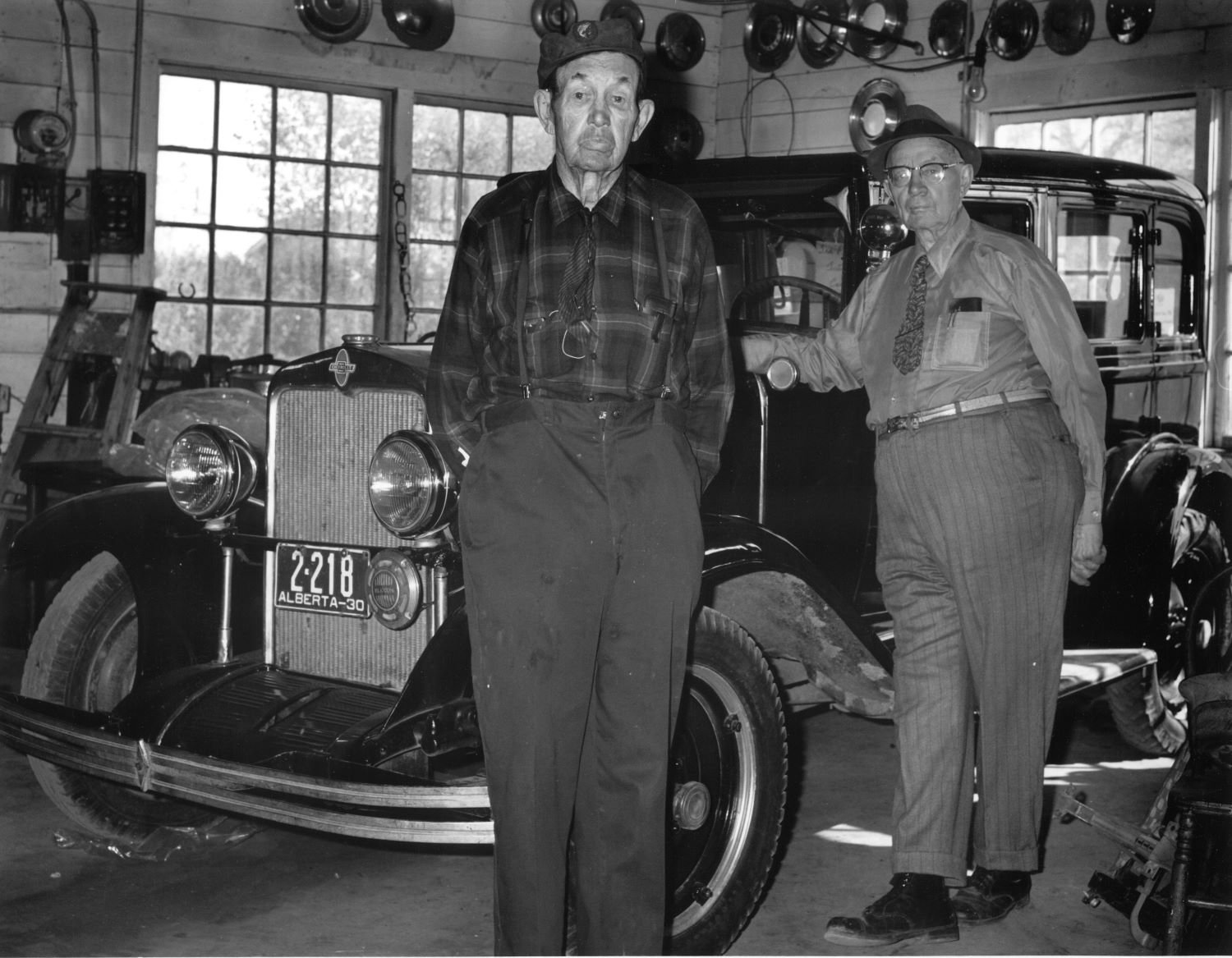
Smith Brothers, Milk River (cat#38), 1973, dark-room based selenium toned silver emulsion black & white photograph, 16 x 20 inches (40.5 x 51 cm), ($2200 Cdn, category E); 11x14 inches (28 x 35.5 cm), ($825 Cdn, category D).
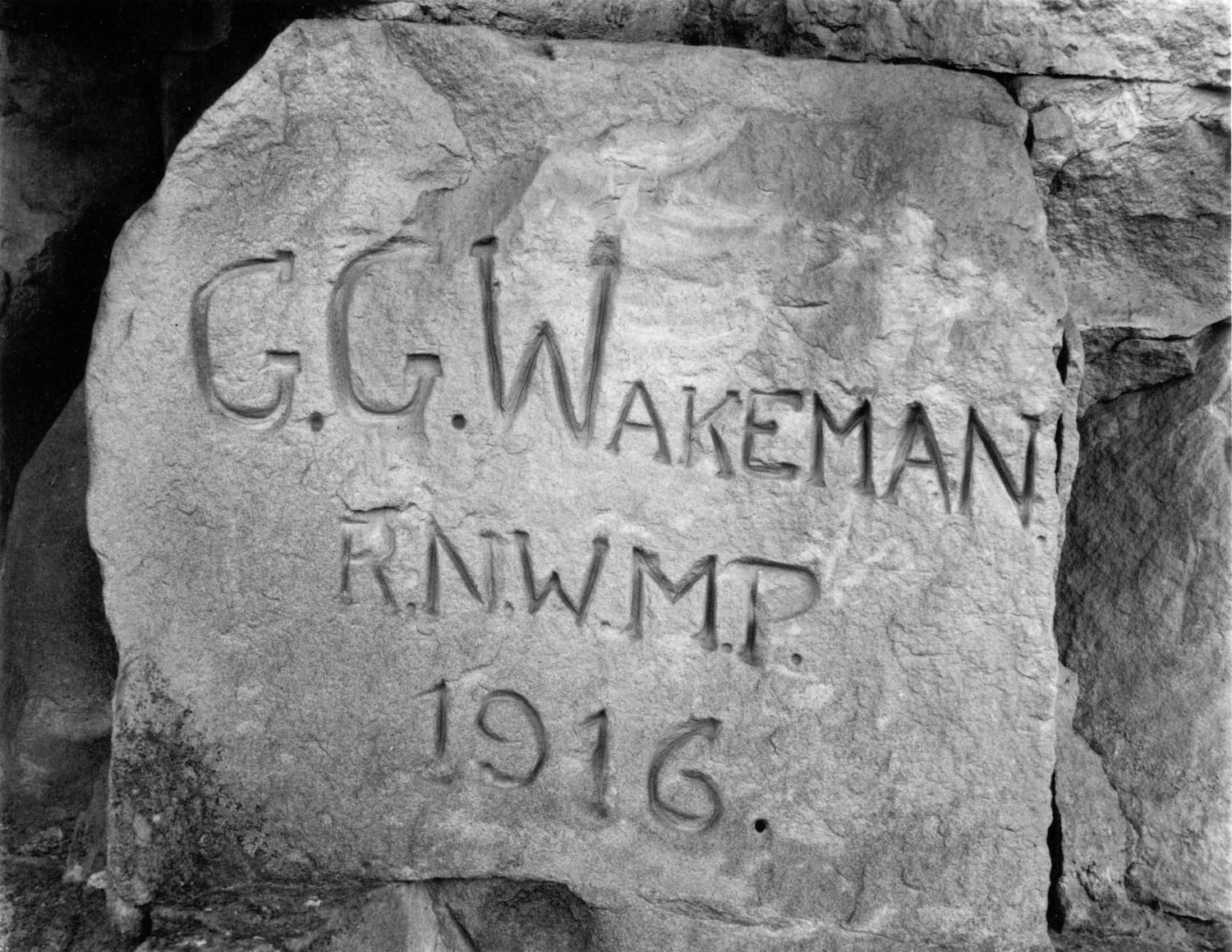
G.G. Wakeman RNWMP 1916 (cat#39), c.1971, darkroom-based selenium toned silver emulsion black and white photograph, 8x10 inches (20.5 x 25.5 cm), ($625 Cdn, category C).
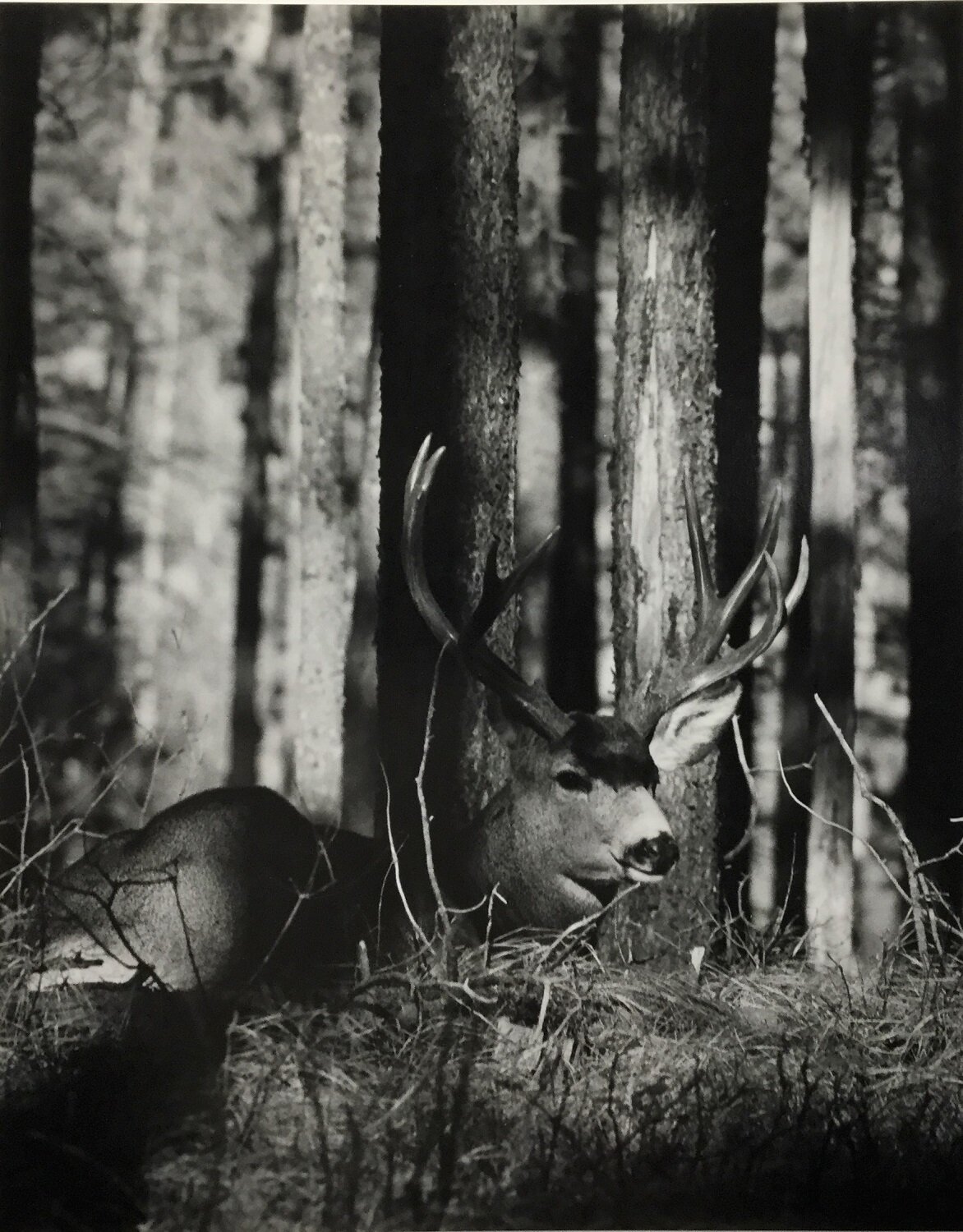
Mule Deer In Shadow (cat#42), 1973, dark-room based selenium toned silver emulsion black & white photograph, framed, 10 x 8 inches (25.5 x 20.5 cm), ($625 Cdn, category C).

Nanny (Mountain Goat) (cat#43), 1973, dark-room based selenium toned silver emulsion black & white photograph, framed, 10 x 8 inches (25.5 x 20.5 cm), ($625 Cdn, category C).

Hoary Marmot (cat#46), 1971, dark-room based selenium toned silver emulsion black & white photograph, framed, 10 x 8 inches (25.5 x 20.5 cm), ($625 Cdn, category C).
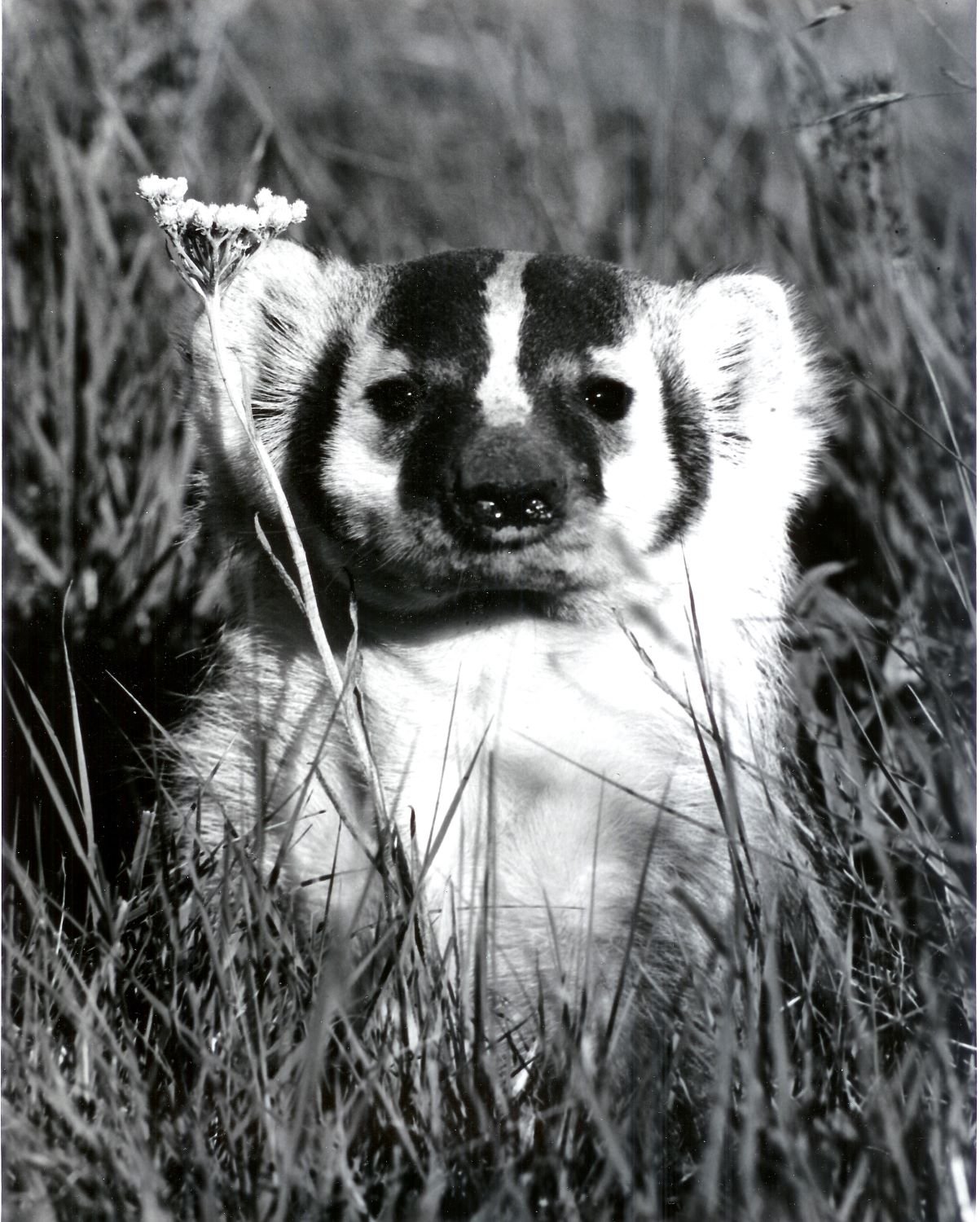
Young Badger, Buffalo Paddock, Waterton (cat#47), 1972, dark-room based selenium toned silver emulsion black & white photograph, framed, 14 x 11 inches (35.5 x 28 cm), ($825 Cdn, category D); 10 x 8 inches (25.5 x 20.5 cm), ($625 Cdn, category C), and 5.5 x 4.5 inches (14 x 11.5 cm), ($300 Cdn, category A).

Mountain Goats: Nanny and Kid (cat#48), 1973, dark-room based selenium toned silver emulsion black & white photograph, framed, 8 x 10 inches (25.5 x 20.5 cm), ($625 Cdn, category C).
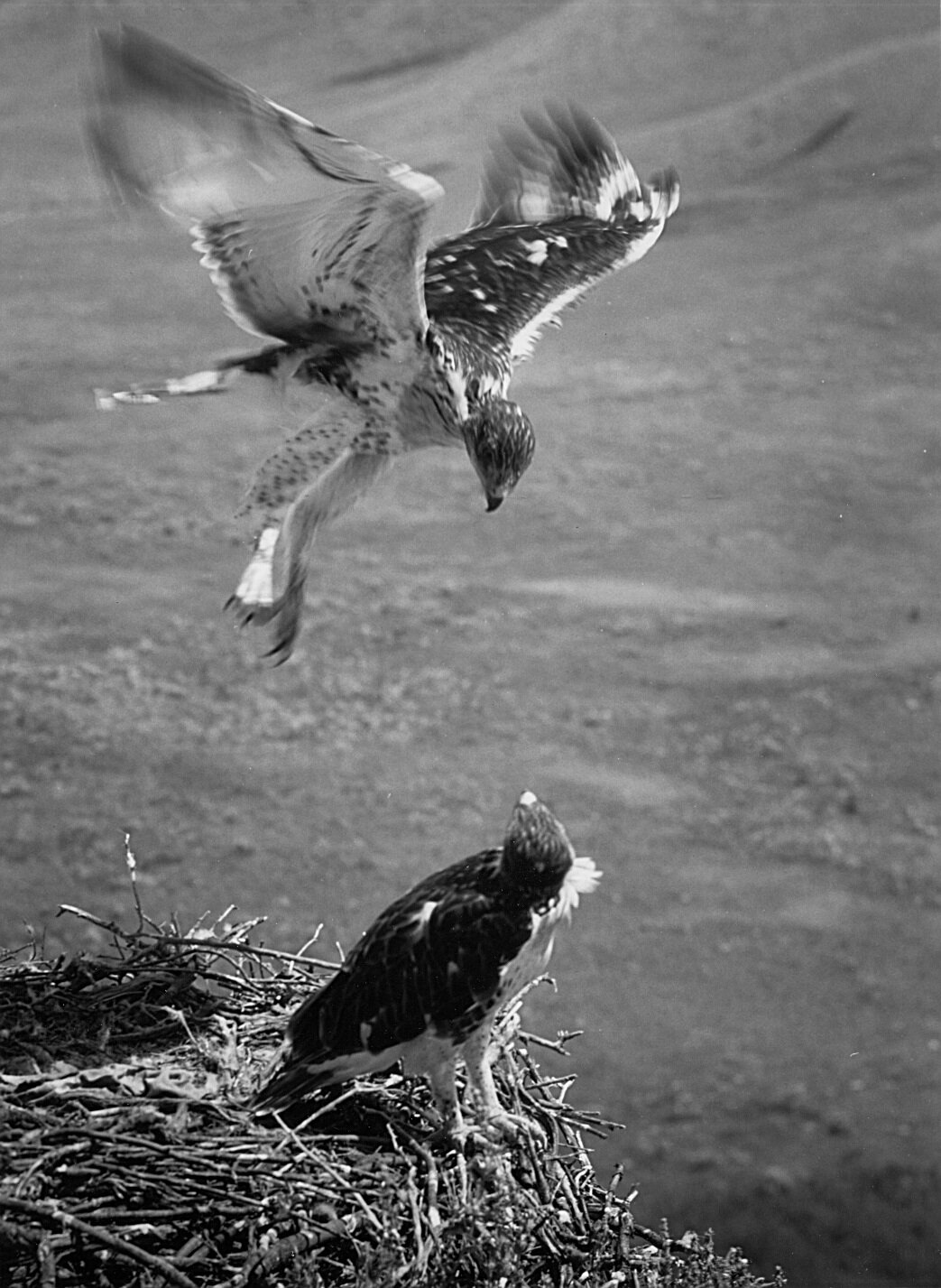
Young Ferruginous Hawks, Milk River Valley, c.1968, (cat.#49) dark-room based selenium toned silver emulsion black & white photograph, framed, 4.5 x 3.5 inches (11.5 x 9 cm), ($300 Cdn, category A).
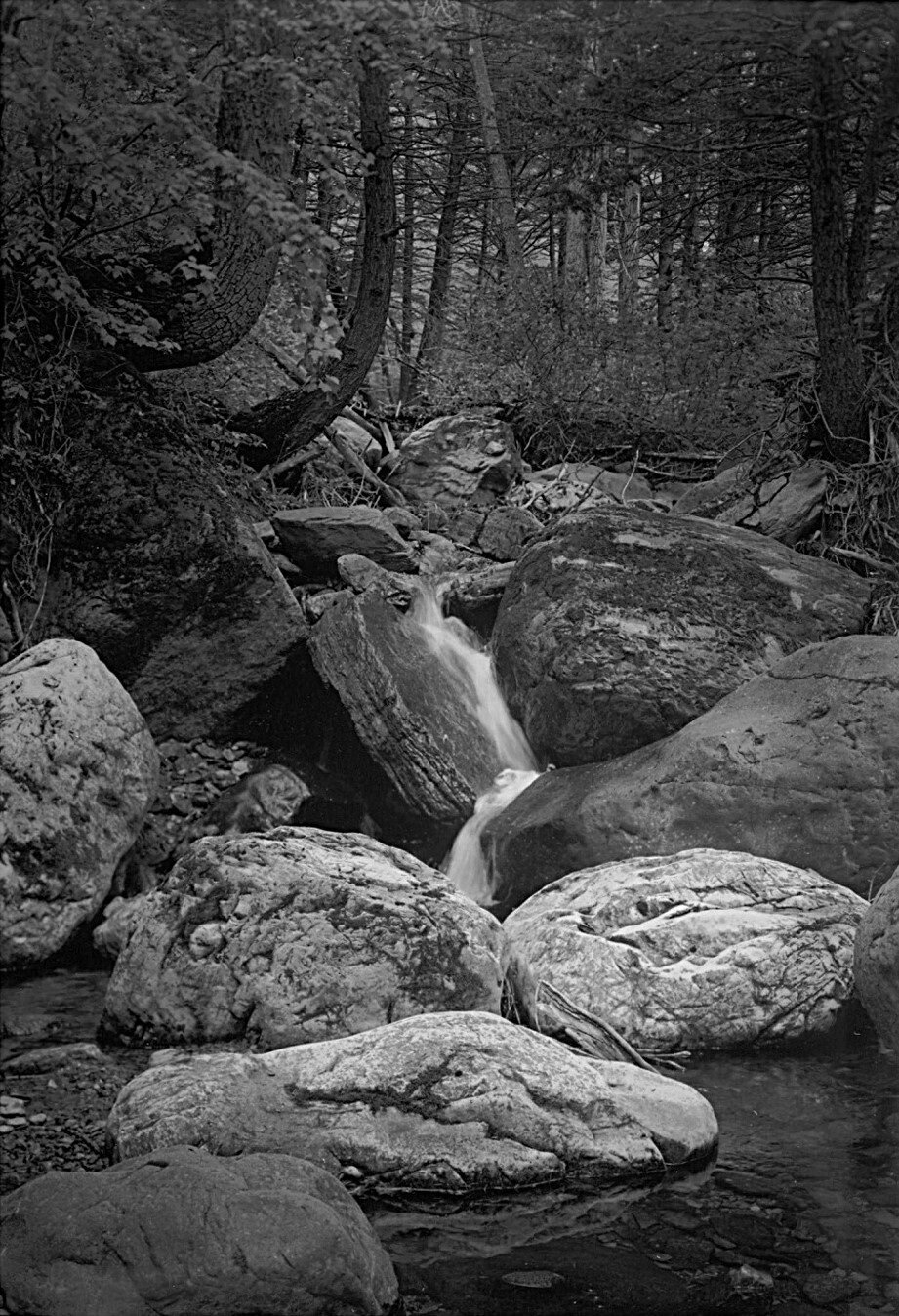
Coppermine Creek, Study #1, Waterton (cat#50), 2000, dark-room based selenium toned silver emulsion black & white photograph, framed, 14 x 11 inches (35.5 x 28 cm), ($825 Cdn, category D).
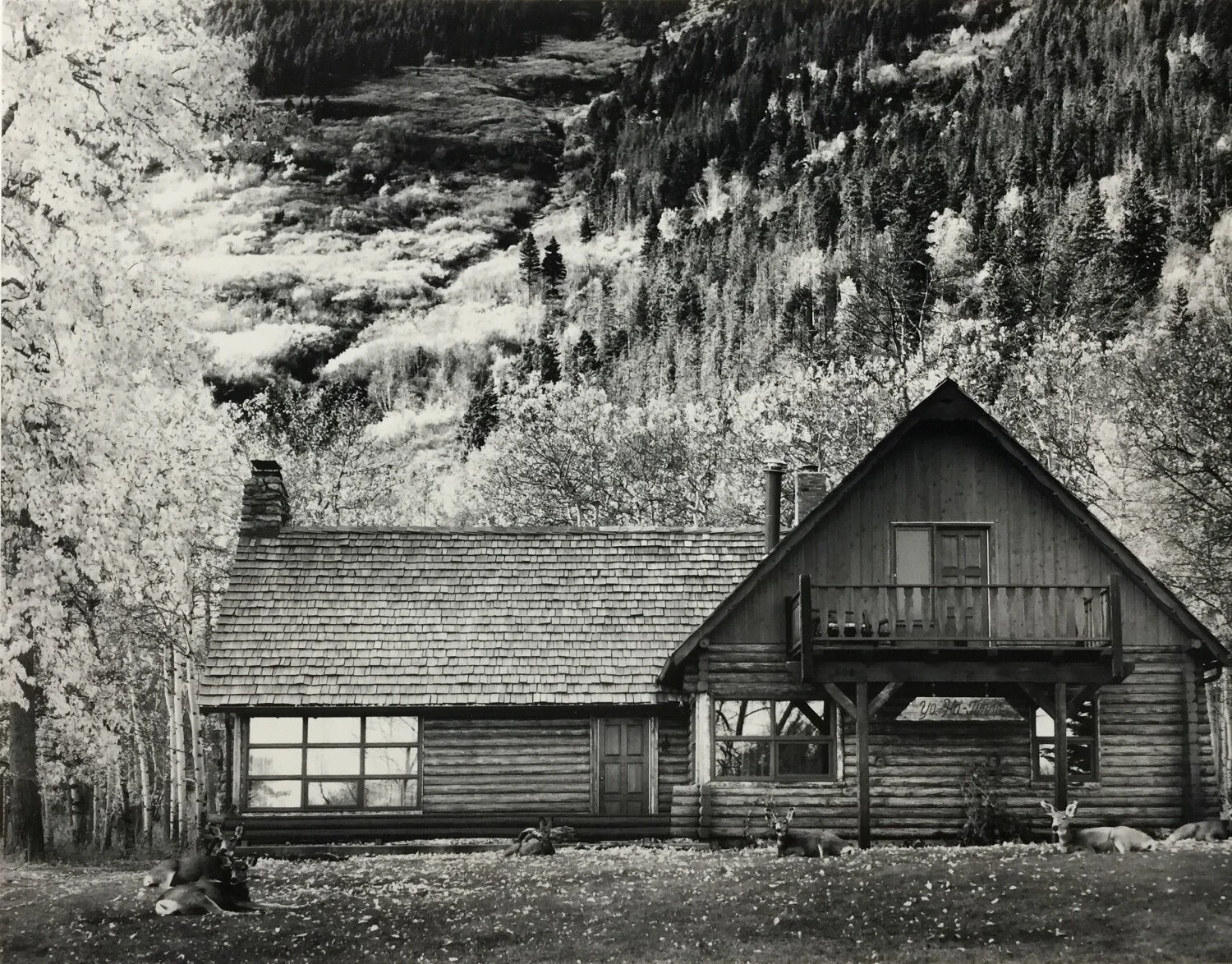
Mule Deer at Ya Ha Tinda (cat#52), 1983, dark-room based selenium toned silver emulsion black & white photograph, framed, 8 x 10 inches (25.5 x 20.5 cm), ($625 Cdn, category C).

Ice Fog, Emerald Bay, Waterton (cat#56), 2000, dark-room based selenium toned silver emulsion black & white photograph, framed in metal, 20 x 16 inches (51 x 40.5 cm), ($2200 Cdn, category E) and 14x11 inches (35.5 x 28 cm), ($825 Cdn, category D).

Sunrise, Livingstone Range (cat#58), 2001, dark-room based selenium toned silver emulsion black & white photograph, framed, 20 x 24 inches (51x61 cm), ($3200 Cdn, category F, edition 34/110) and 11 x 14 inches (28 x 35.5 cm), ($825 Cdn, category D).

Upper Waterton Valley, Study #2 (cat#75), 2001, dark-room based selenium toned silver emulsion black & white photograph, framed, 16x20 inches (40.5 x 51 cm), ($2200 Cdn, category E).

Antelope (Cypress Hills) (cat#78), 1972, dark-room based selenium toned silver emulsion black & white photograph, framed, 8 x 10 inches (20.5 x 25.5 cm), ($625 Cdn, category C).

Petroglyphs, Cliff Face, Police Coulee, Milk River Valley (cat#79), 1971, dark-room based selenium toned silver emulsion black & white photograph, 24x20 inches (61x51 cm), ($3200 Cdn, category F); 20 x 16 inches (51 x 40.5 cm) ($2200 Cdn, category E) and 14 x 11 inches (35.5 x 28 cm), ($825 Cdn, category D).
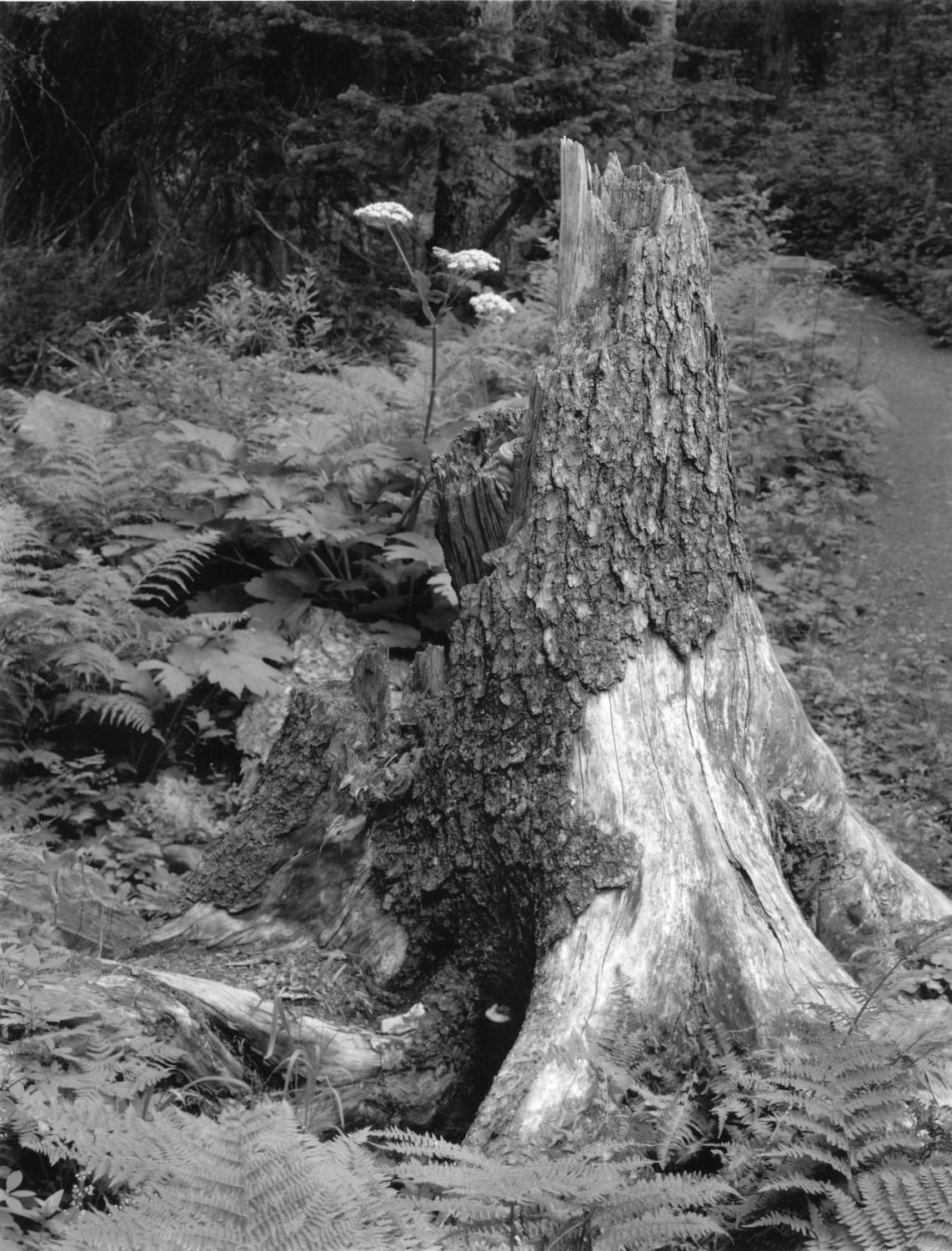
Summit Lake Trail, Waterton (cat#80), 2002, dark-room based selenium toned silver emulsion black & white photograph, framed, 20 x 16 inches (51x40.5 cm), ($2200 Cdn, category E); 14 x 11 inches (35.5 x 28 cm) ($825 Cdn., category D).

Forest Floor, Glacier National Park (cat#82), 2002, dark-room based selenium toned silver emulsion black & white photograph, framed, 11 x 14 inches (20.5 x 25.5 cm) ($825 Cdn, category D).

Red Rock Canyon, Waterton Lakes National Park (cat#83), 2002, dark-room based selenium toned silver emulsion black & white photograph, framed, 14 x 11 inches (35.5 x 28 cm) ($825 Cdn, category D).
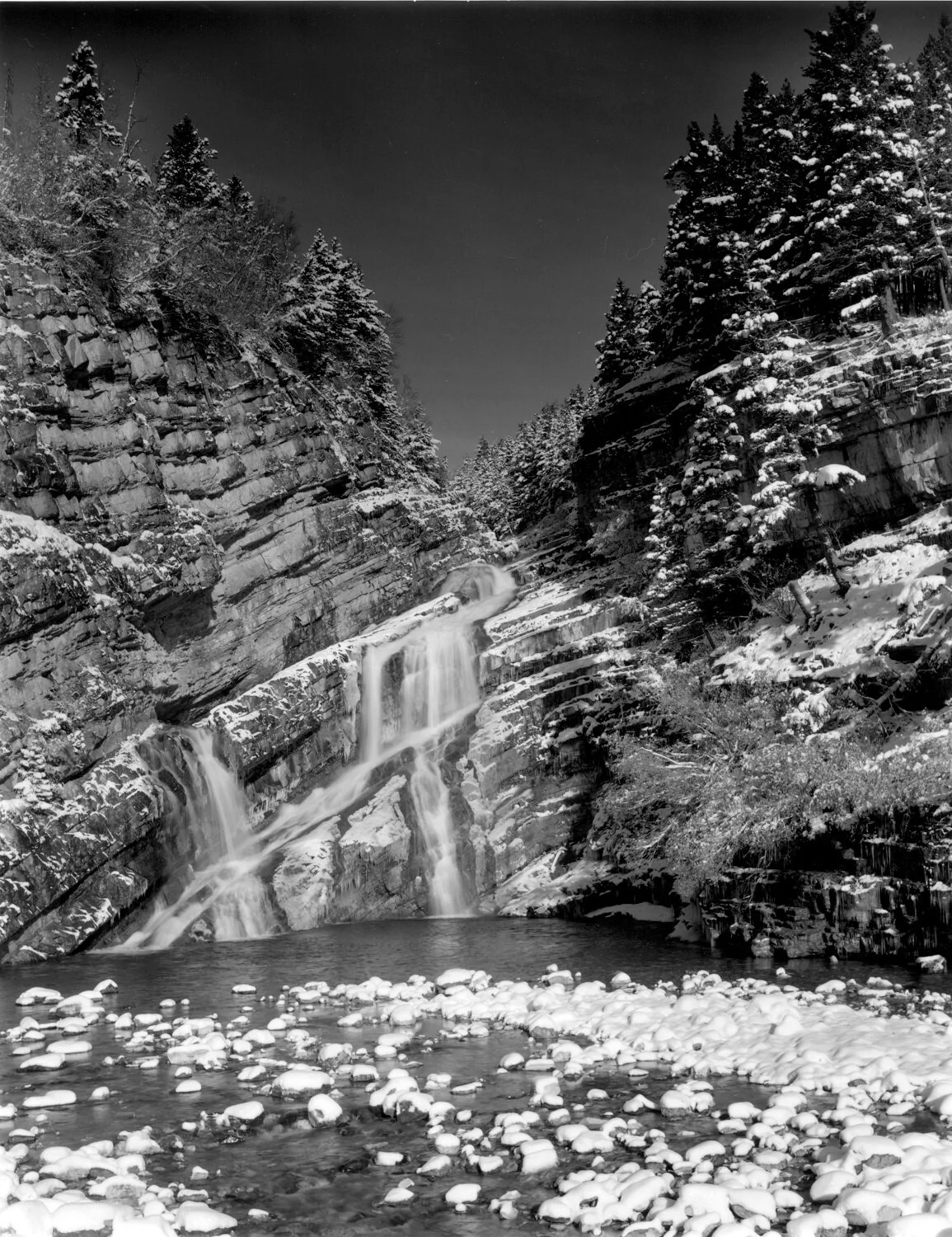
Cameron Falls, October Snowfall (cat#84), 2002, dark-room based selenium toned silver emulsion black & white photograph, framed, 24 x 20 inches (61x51 cm), ($3200 Cdn, category F); 20 x 16 inches (51 x 40.5 cm), ($2200 Cdn, category E).
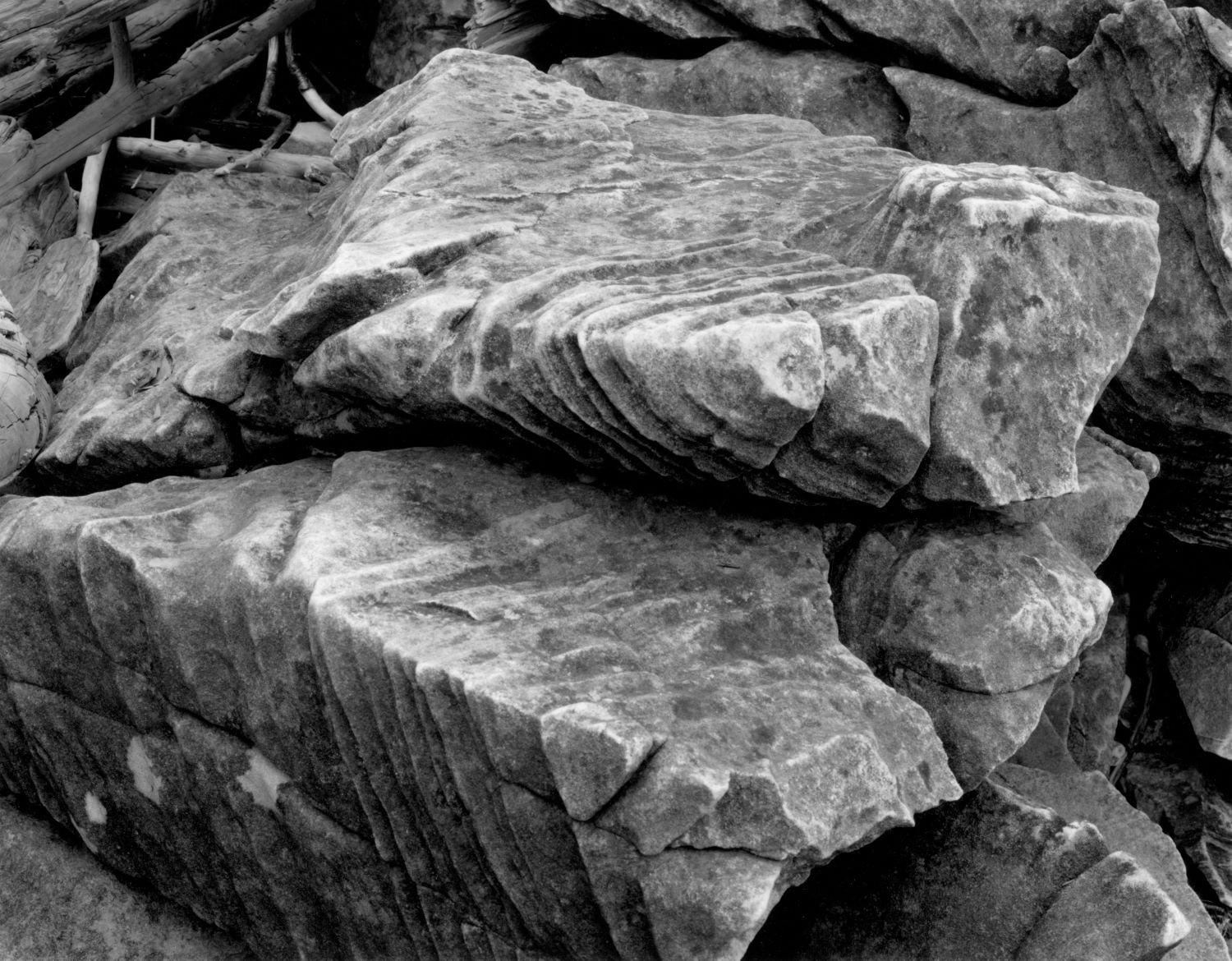
Sandstone Boulder, GNP (Goat Haunt) (cat#85), 2002, dark-room based selenium toned silver gelatin black & white photograph, framed, 16 x 20 inches (40.5 x 51 cm), ($2200 Cdn, category E).
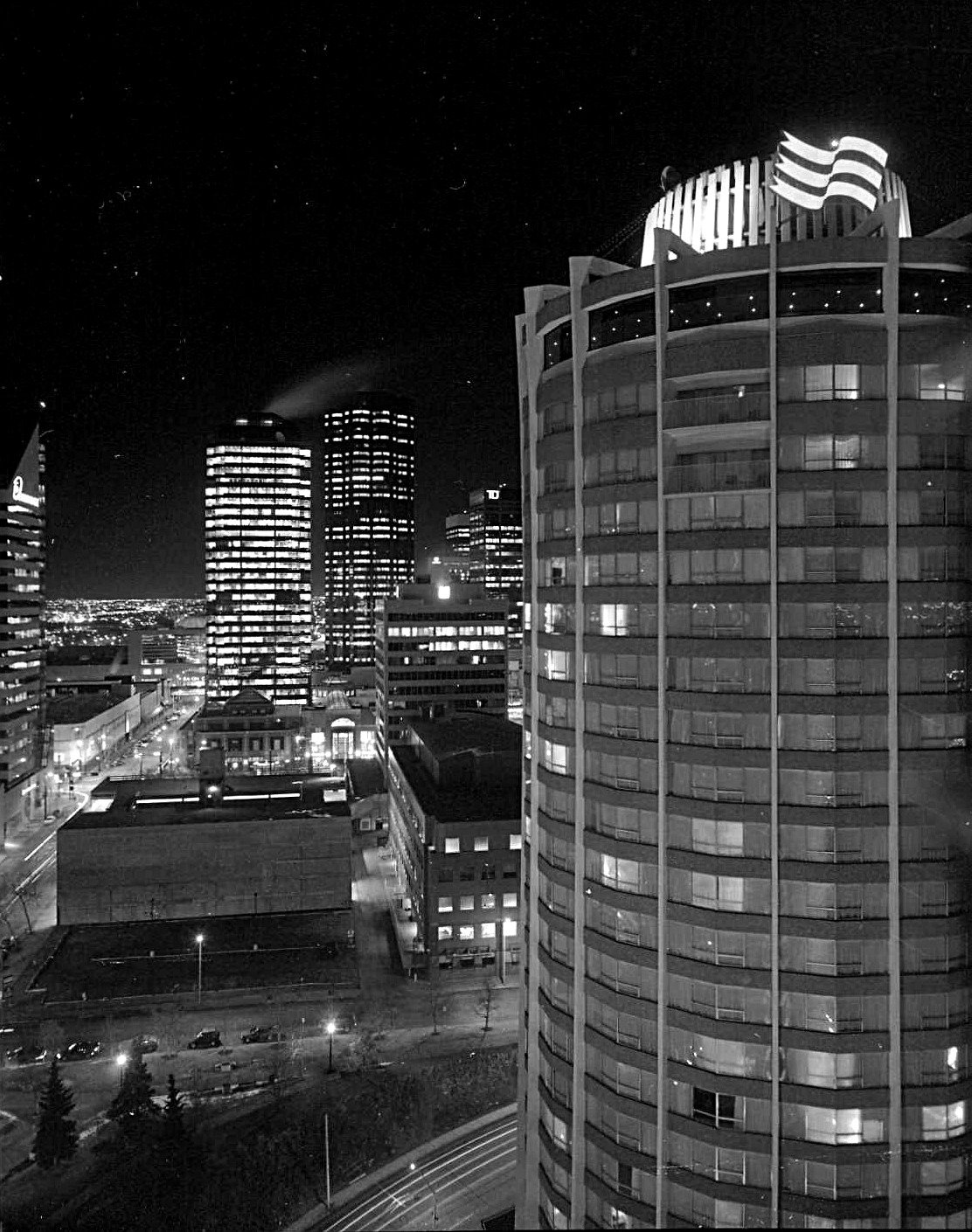
Downtown 1, Edmonton (cat#88-1), 2001, dark-room based selenium toned silver emulsion black & white photograph, 20 x 16 inches (51 x 40.5 cm), framed, ($2200 Cdn, category E); 14 x 11 inches (35.5 x 28 cm), ($625 Cdn, category D).

South from Logan Pass, Glacier National Park, Montana (cat#89), 2003, dark-room based selenium toned silver emulsion black & white photograph, framed, 16 x 20 inches (40.5 x 51 cm) ($2200 Cdn, category E); 11 x 14 inches (28 x 35.5 cm) ($825 Cdn, category D).

Trail of the Cedars, Glacier National Park, Montana, 2003 (cat#91), dark-room based selenium toned silver emulsion black & white photograph, framed, 24 x 20 inches (61 x 51 cm), (category F is sold out); however still available in 20 x 16 inches (51 x 40.5 cm), ($2200 Cdn, category E) and 14 x 11 inches (35.5 x 28 cm), $825 Cdn, category D).
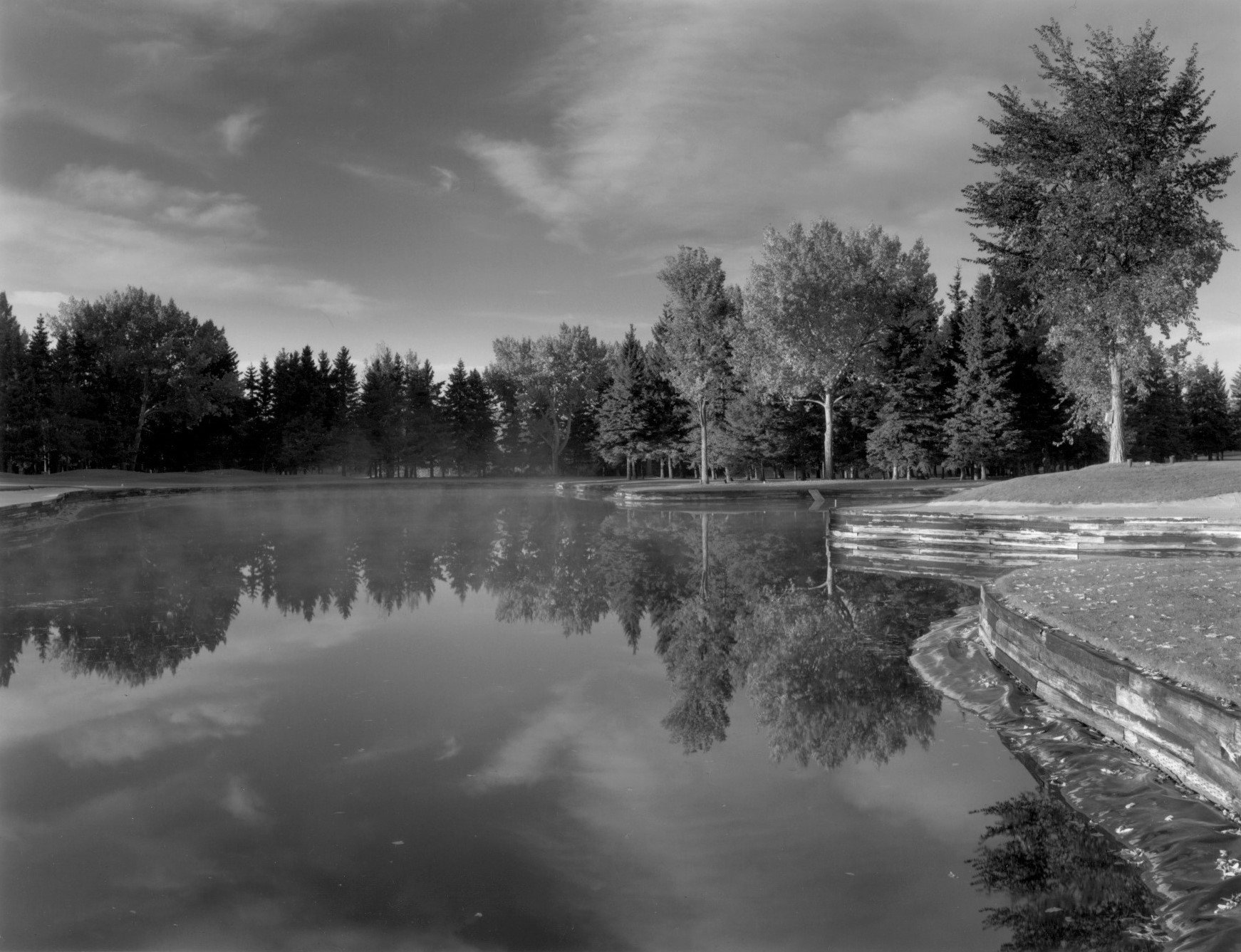
Mayfair Golf & Country Club, Edmonton: Pond At Dawn (cat#92.14), 2004, dark-room based selenium toned silver emulsion black & white photograph, framed, 20 x 24 inches (51 x 61 cm), ($3200 Cdn, category F).
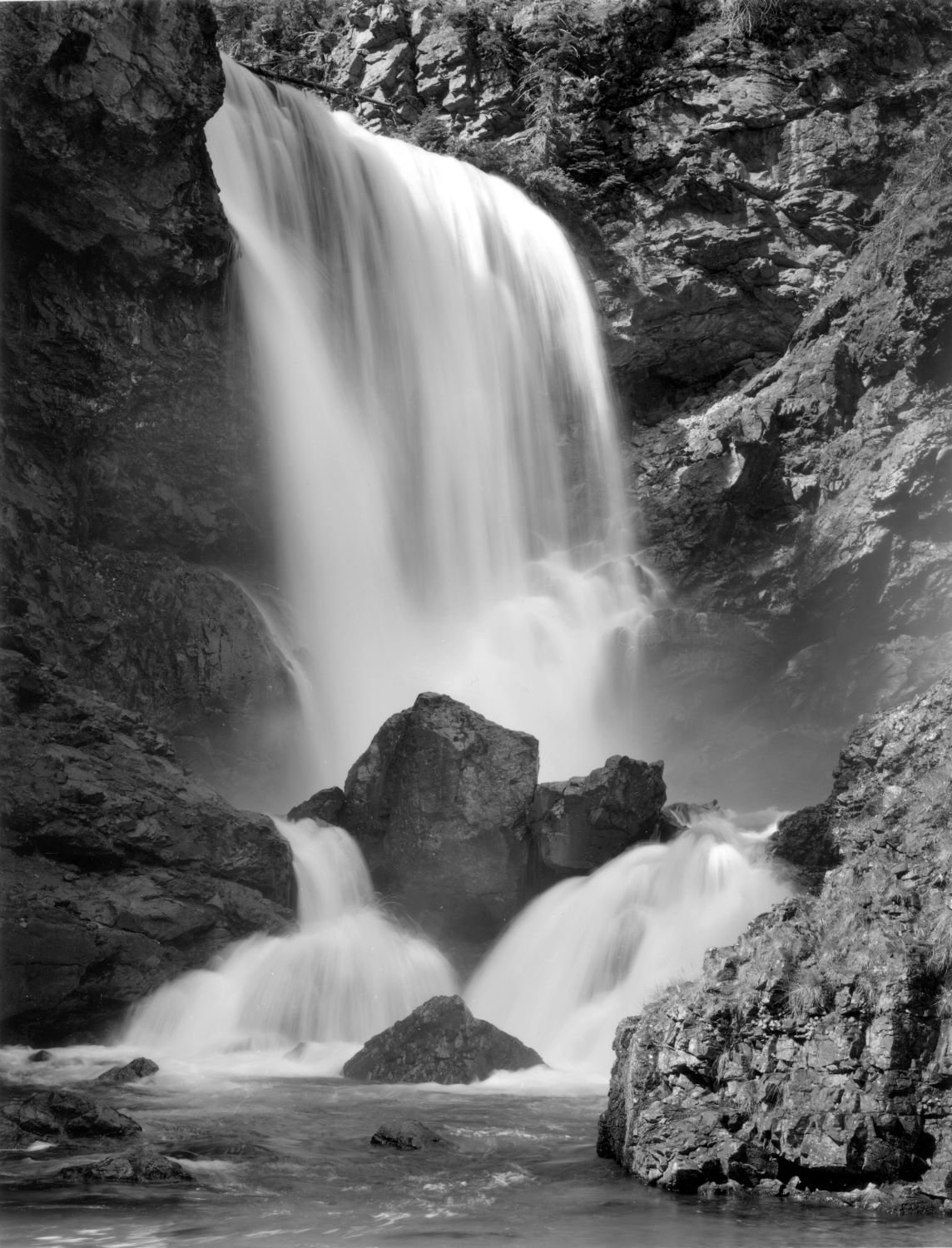
Dawn Mist Falls, GNP (cat#95), 2004, dark-room based selenium toned silver emulsion black & white photograph, framed, 24 x 20 inches (61 x 51 cm) ($3200 Cdn, category F); 14 x 11 inches (35.5 x 28 cm), ($825 Cdn, category D).
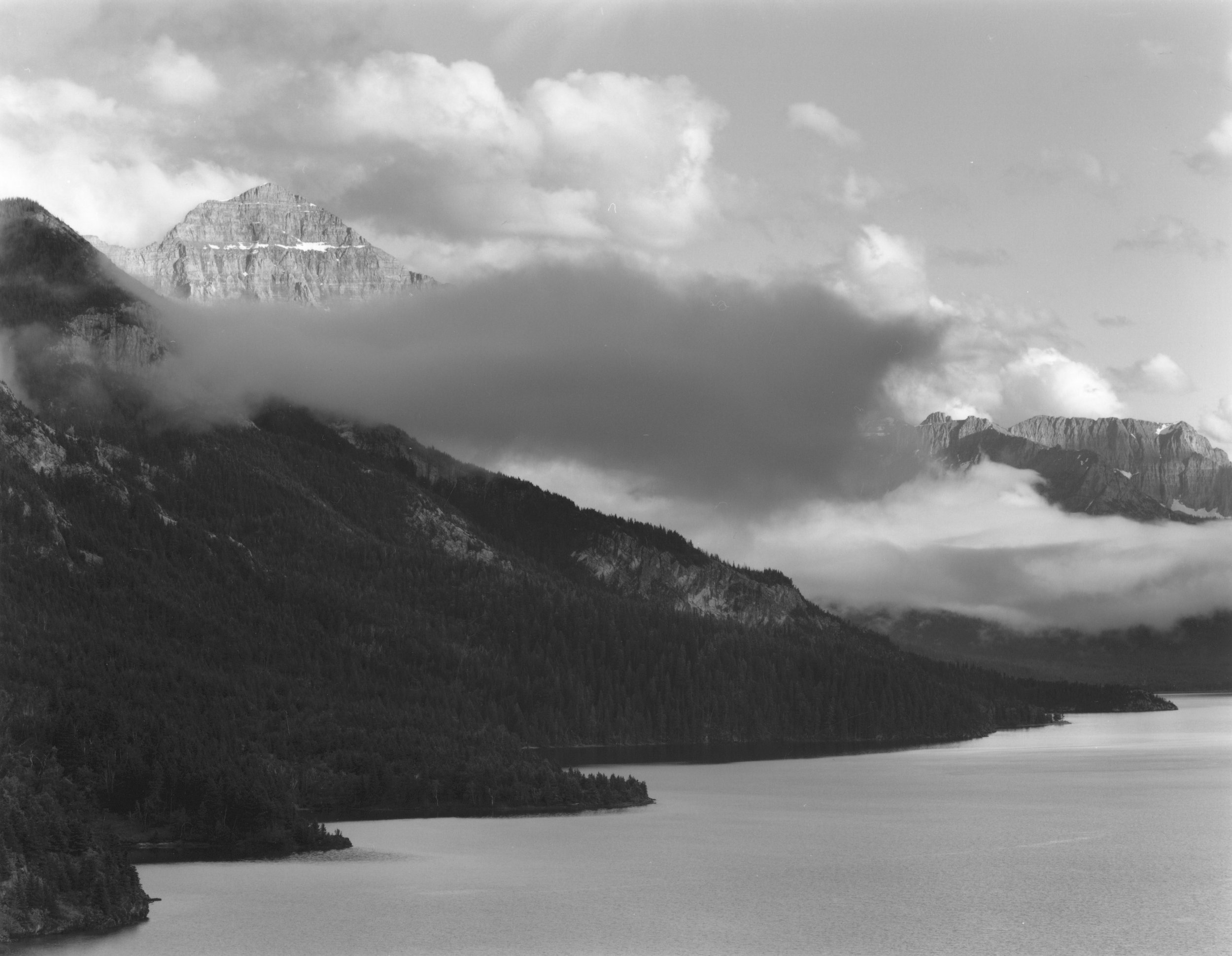
Head Of The Lake Study #1 (cat#97), 2004, dark-room based selenium toned silver emulsion black & white photograph, framed, 16 x 20 inches (40.5 x 51 cm), ($2200 Cdn, category E) and 11 x 14 inches (28 x 35.5 cm), ($825 Cdn, category D).

Head Of The Lake Study #1 and #2 (diptych) (cat#97-8), 2004, dark-room based selenium toned silver emulsion black & white photograph, framed separately in metal, 16 x 20 inches (40.5 x 51 cm) each ($4100 Cdn, category H); also available separately 16 x 20 inches (40.5 x 51 cm), ($2200 Cdn, category E).
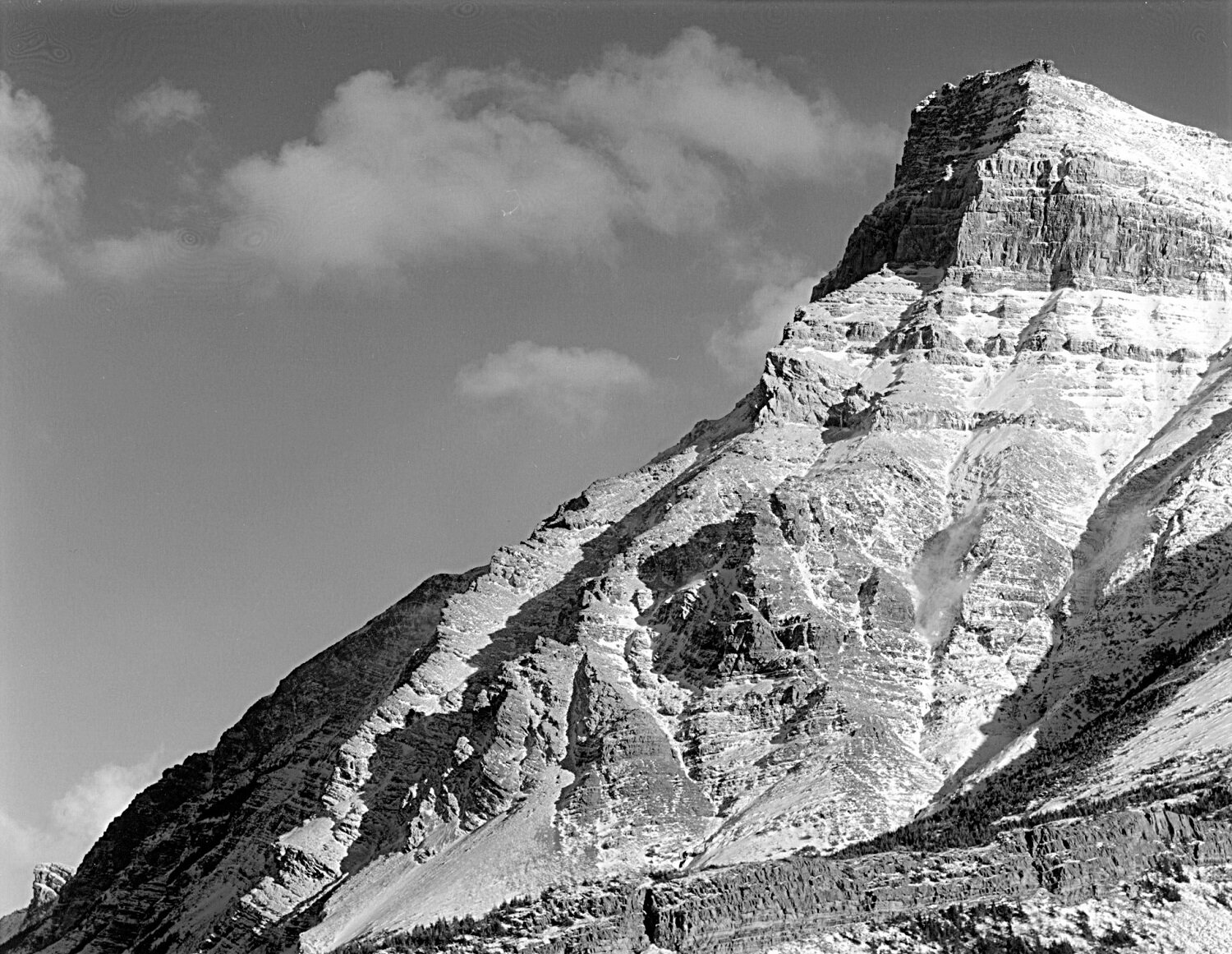
Vimy Peak, Waterton (cat#100), 2004, dark-room based selenium toned silver emulsion black & white photograph, framed, 20 x 24 inches (51x61 cm), ($3200 Cdn, category F), 16 x 20 inches (40.5 x 51 cm), ($2200 Cdn, category E), 5 x 7 inches (13 x 18 cm), ($400 Cdn, category B).
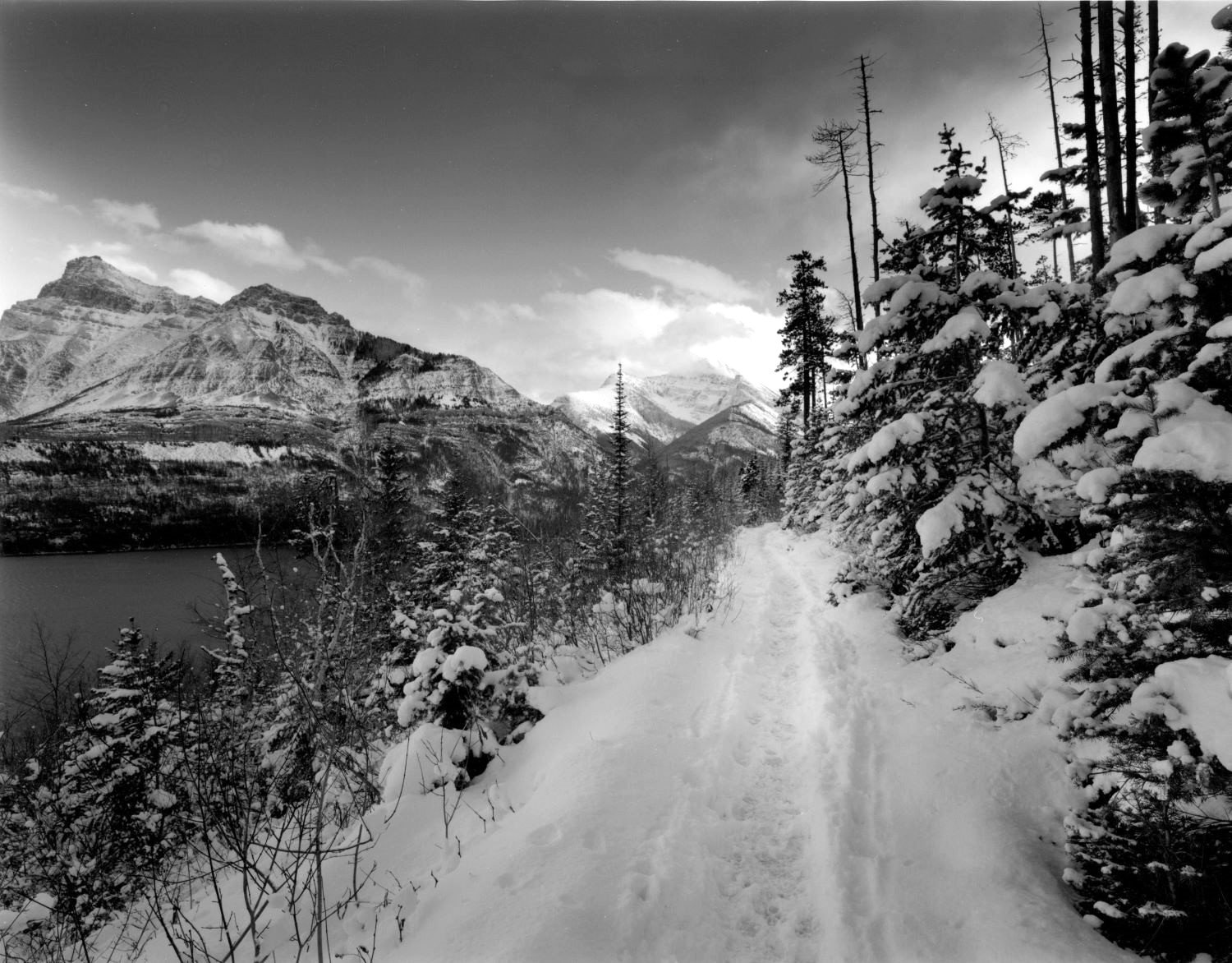
Bertha Lake Trail, December (cat#101), 2004, dark-room based selenium toned silver emulsion black & white photograph, 20 x 24 inches (51x61 cm), ($3200 Cdn, category F), 16 x 20 inches (40.5 x 51 cm), framed, ($2200 Cdn, category E).

Goat Haunt and Cleveland Study No. 1, 2004 (cat#102), dark-room based selenium toned silver emulsion black & white photograph, framed, 16 x 20 inches (40.5 x 51 cm), ($2200 Cdn, category E).
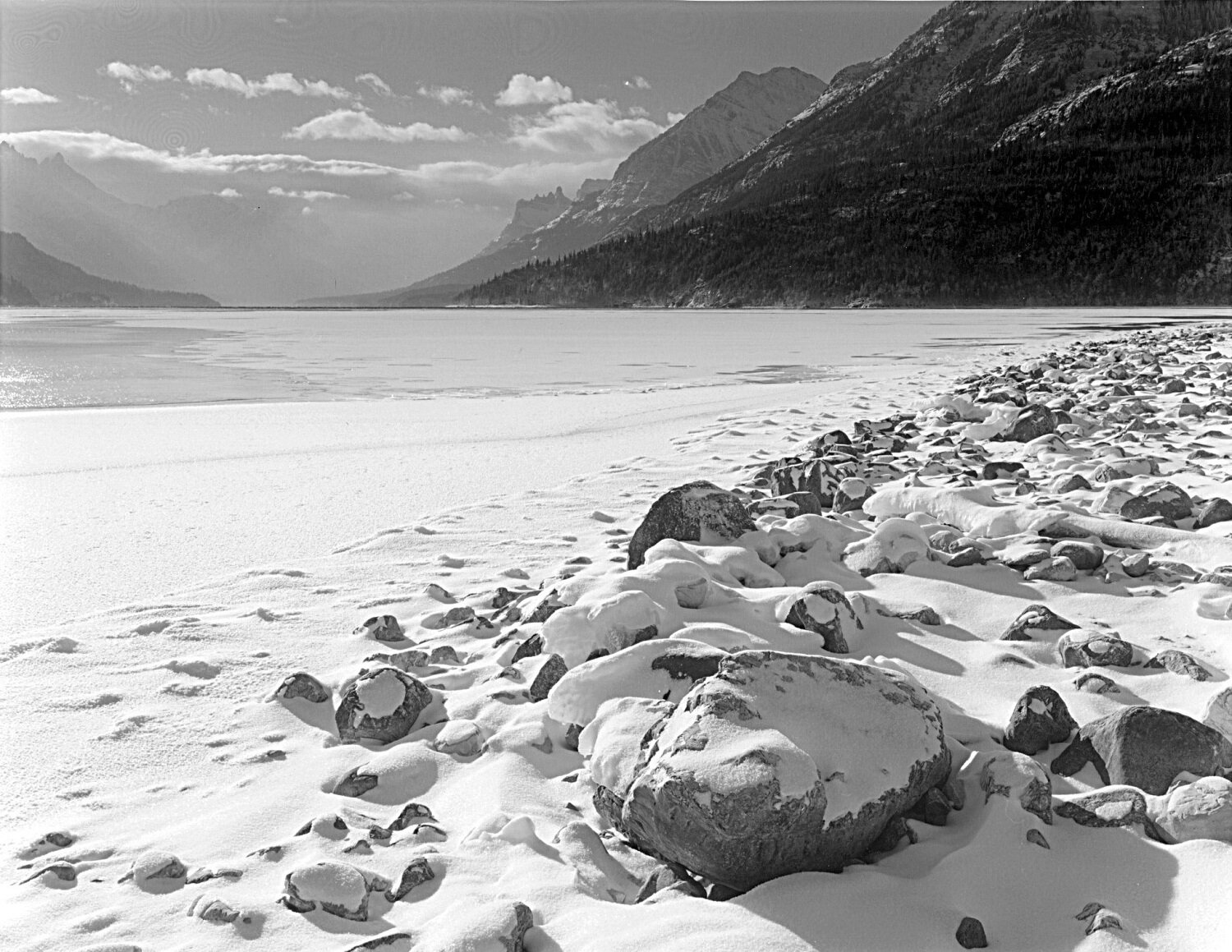
Winter Shoreline, Upper Waterton Lake (cat.#104), 2005, dark-room based selenium toned silver emulsion black & white photograph, 20 x 24 inches (51x61 cm), ($3200 Cdn, category F); 11 x 14 inches (28 x 35.5 cm), ($825 Cdn, category D).

Talus, Boulder Field, Upper Waterton Lake (cat#105), 2005, dark-room based selenium toned silver emulsion black & white photograph, framed, 16 x 20 inches (51 x 40.5 cm), ($2200 Cdn, category E).
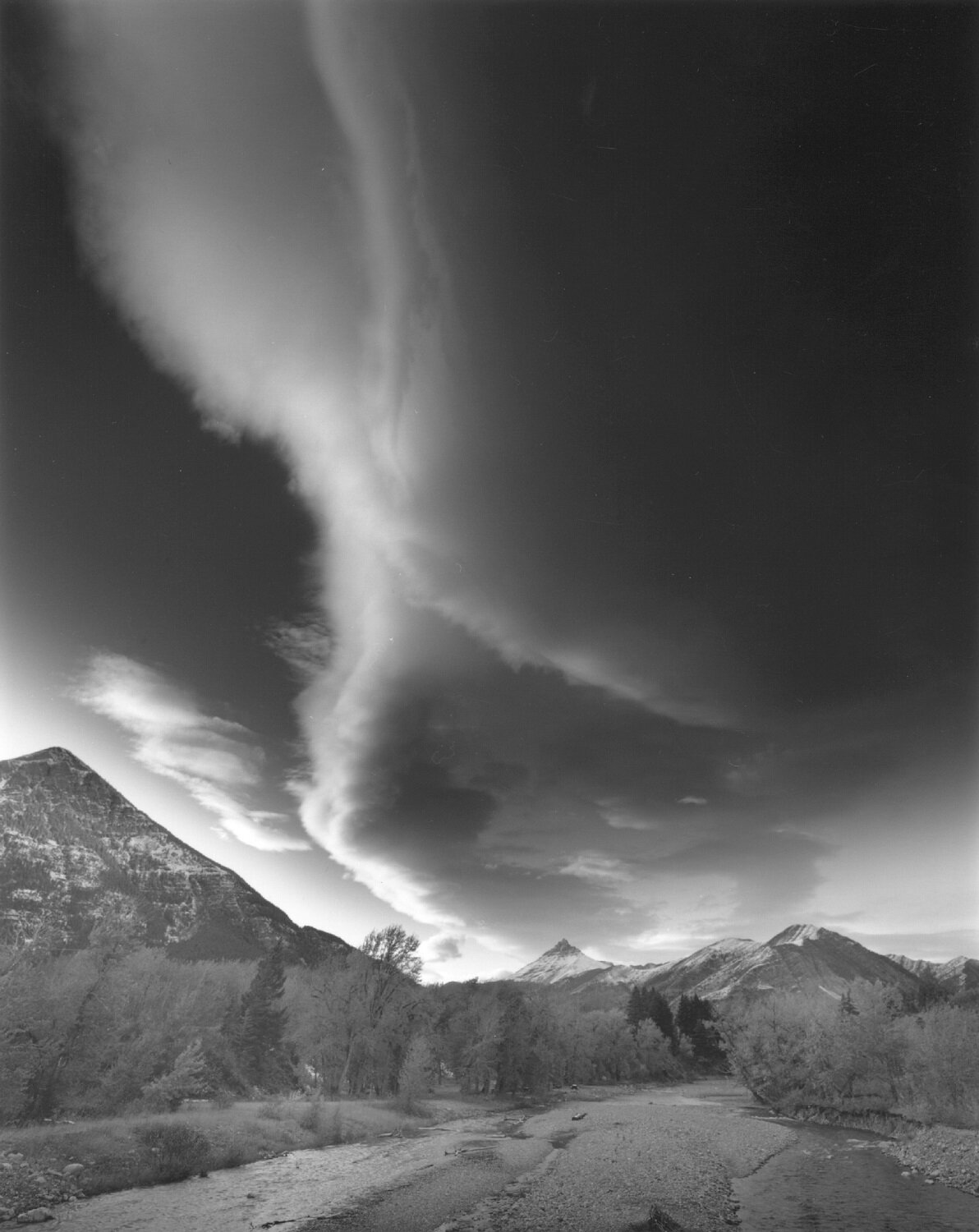
Mount Galwey, Lenticular Cloud (cat#106), 2005, dark-room based selenium toned silver emulsion black & white photograph, framed, 24 x 20 inches (61 x 51 cm), ($3200 Cdn, category F), 20 x 16 inches (category E).
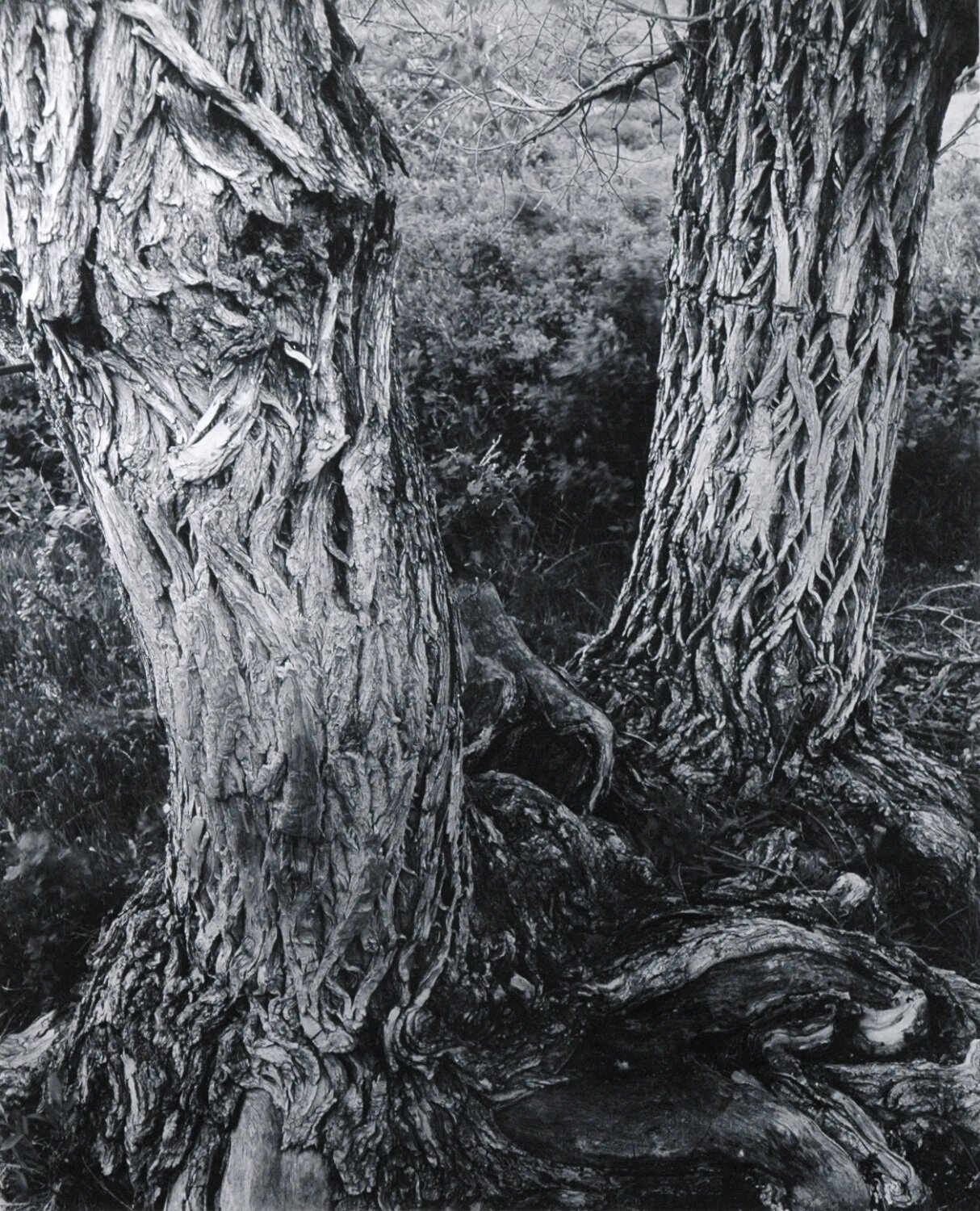
Peach Leaved Willow, Milk River Valley (cat#114), 1971, dark-room based selenium toned silver emulsion black & white photograph, framed, 24 x 20 inches (61 x 51 cm) ($3200 Cdn, category F).

Franklin Gulls, West of Milk River, Alberta (cat#118), c.1972, dark-room based selenium toned silver emulsion black & white photograph, framed, 11 x 14 inches (28x35.5 cm), ($825 Cdn, category D).
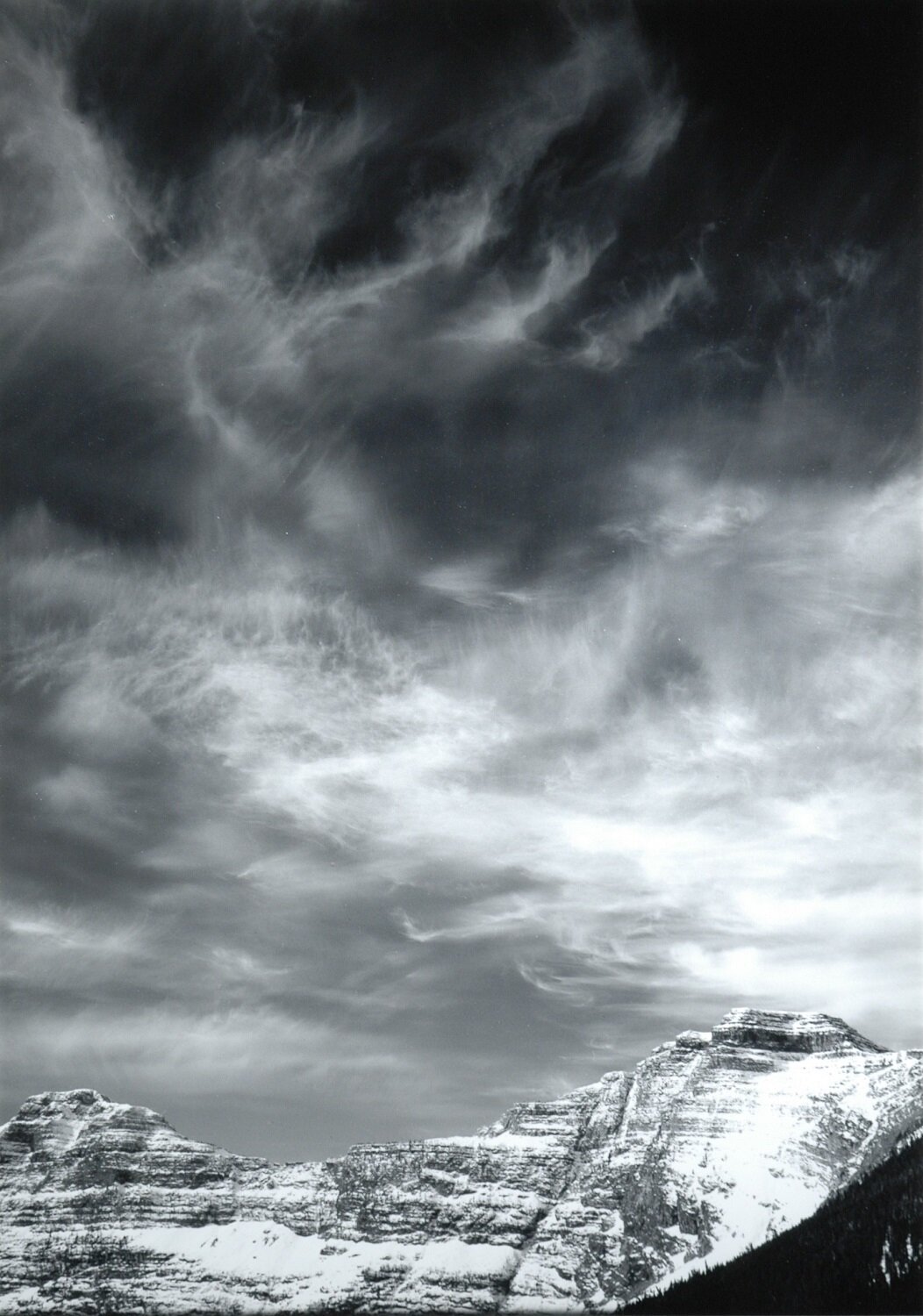
Mount Custer, Cameron Lake, Waterton/Glacier (cat#119), c.1990, dark-room based selenium toned silver emulsion black & white photograph, framed, 20 x 16 inches (51 x 40.5 cm), ($2200 Cdn, category E).
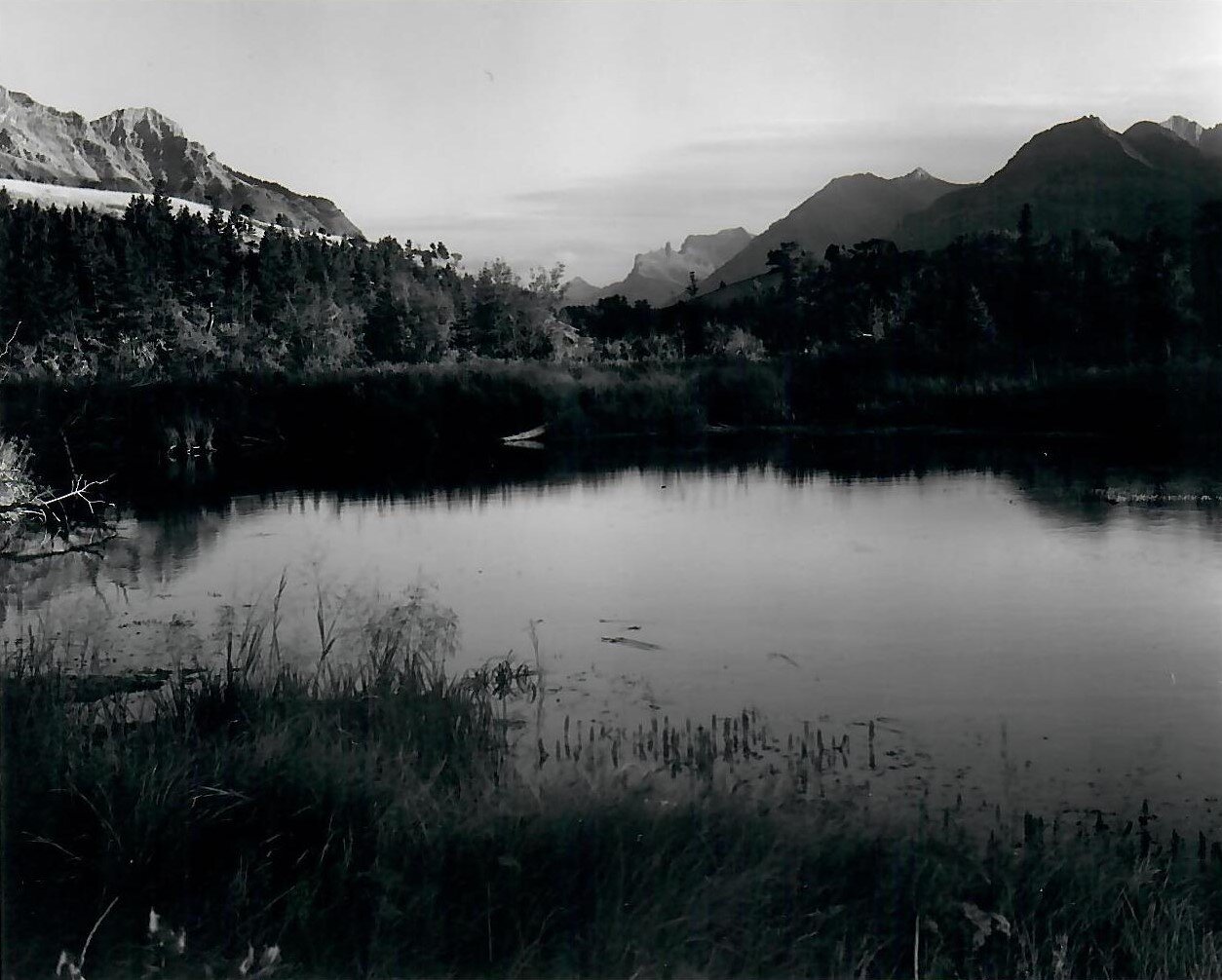
Beaver Pond #2, Blakiston Valley, Waterton, 1980, (cat.#124), dark-room based selenium toned silver emulsion black & white photograph, framed, 3 x 4 inches (8x10 cm), ($300 Cdn, category A).
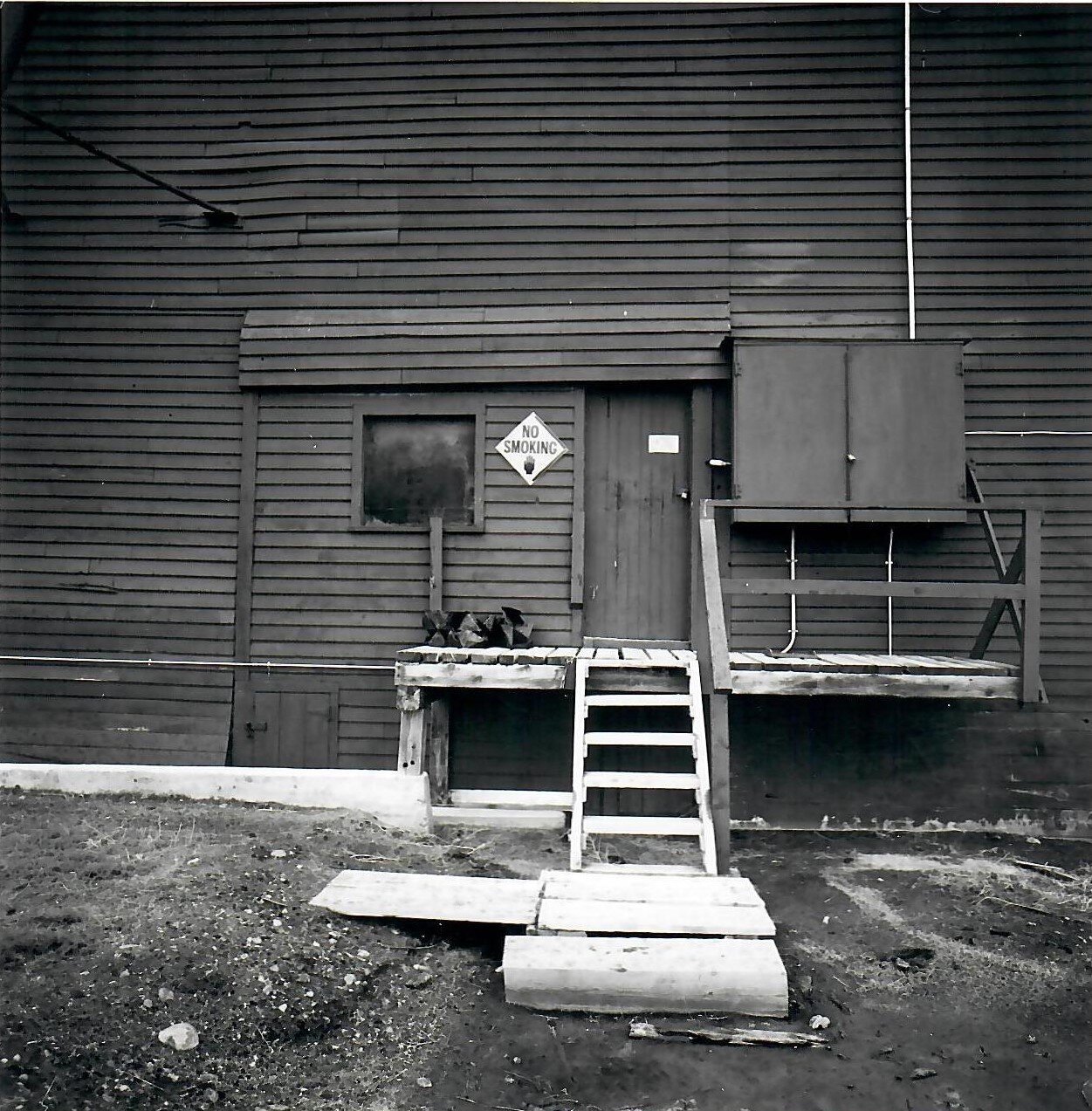
New Dayton Feeds (cat#128), 1975, dark-room based selenium toned silver emulsion black & white photograph, framed, 4 x 4 inches (10x10 cm), ($300 Cdn, category A).

New Dayton Federal Grain Elevator (cat#129), 1975, dark-room based selenium toned silver emulsion black & white photograph, framed, 4.25 x 4 inches (11x10 cm), ($300 Cdn, category A).

West From Akamina Ridge, Waterton, 1973, dark-room based selenium toned silver emulsion black & white photograph, framed, 5 x 5 inches (category A).
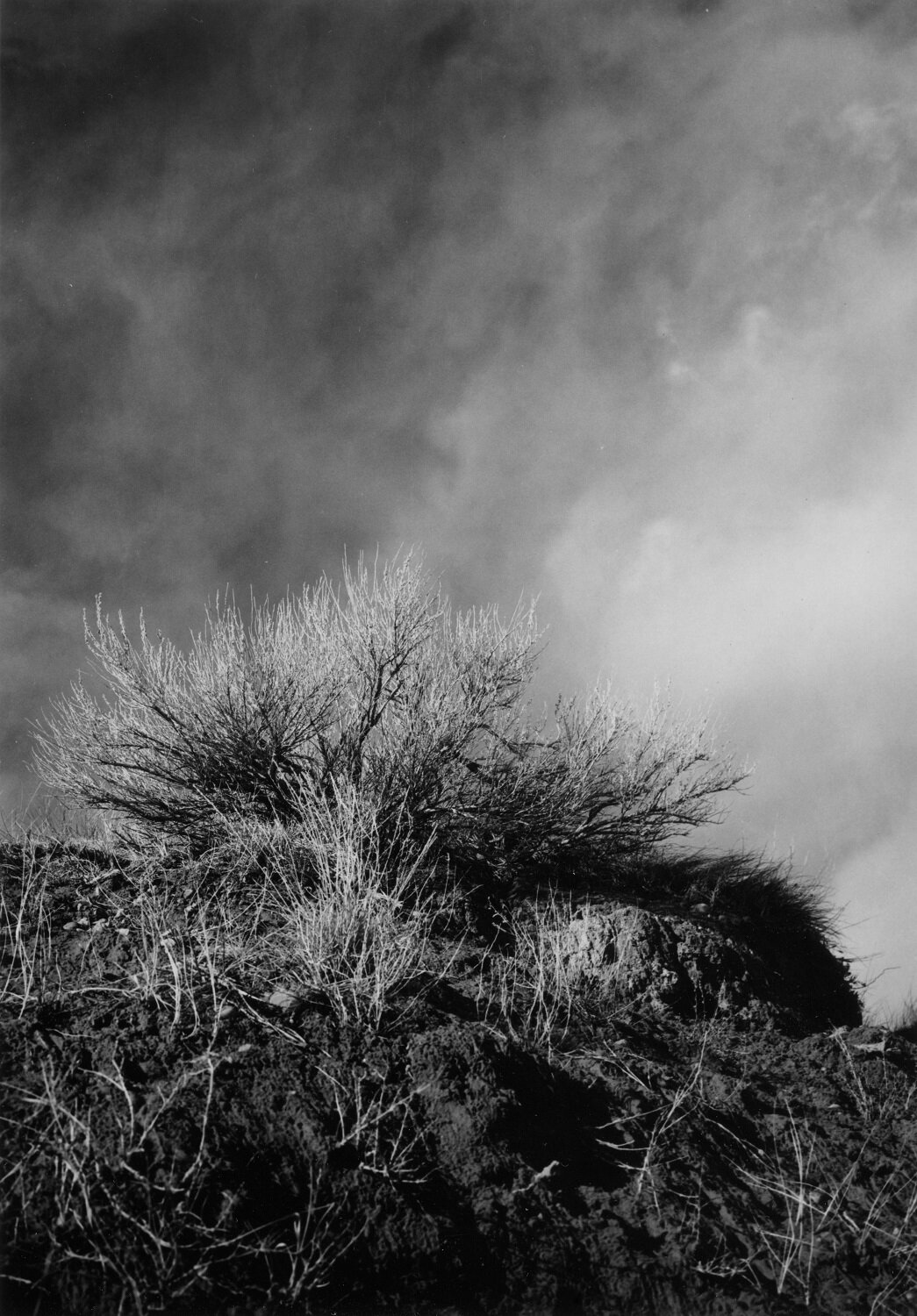
Sage Brush, Milk River Valley, 1968, dark-room based selenium toned silver emulsion black & white photograph, framed, 7 x 5 inches (category B).

Van Cleeve Coulee, Sweetgrass Hills (Milk River, Alberta), 1971, dark-room based selenium toned silver emulsion black & white photograph, framed, 20 x 24 inches (51x61 cm), (sold out, category F); checking for other sizes.
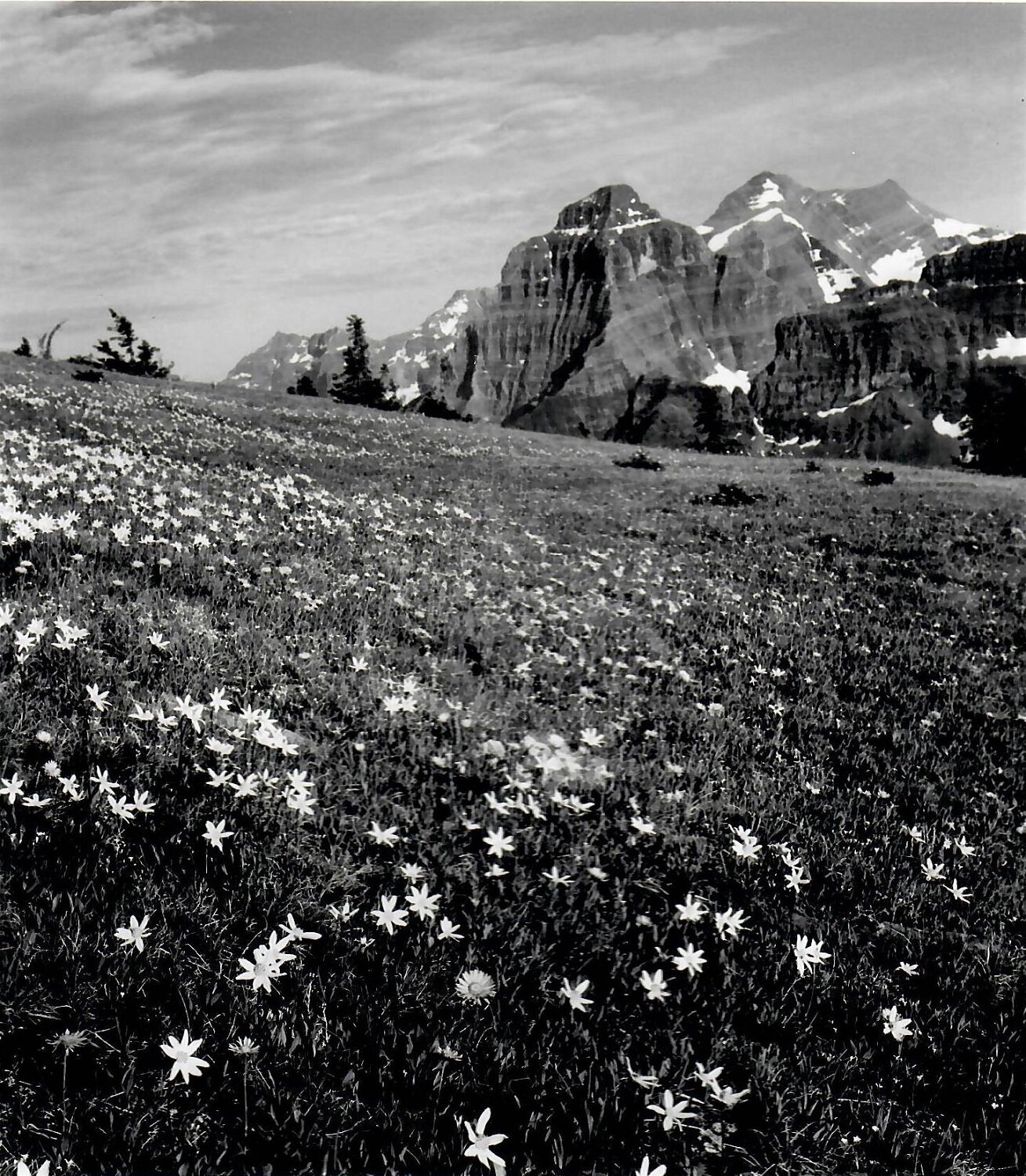
Akamina Meadow, Waterton, c.1973, dark-room based selenium toned silver emulsion black & white photograph, framed, 5 x 4 inches (category A).
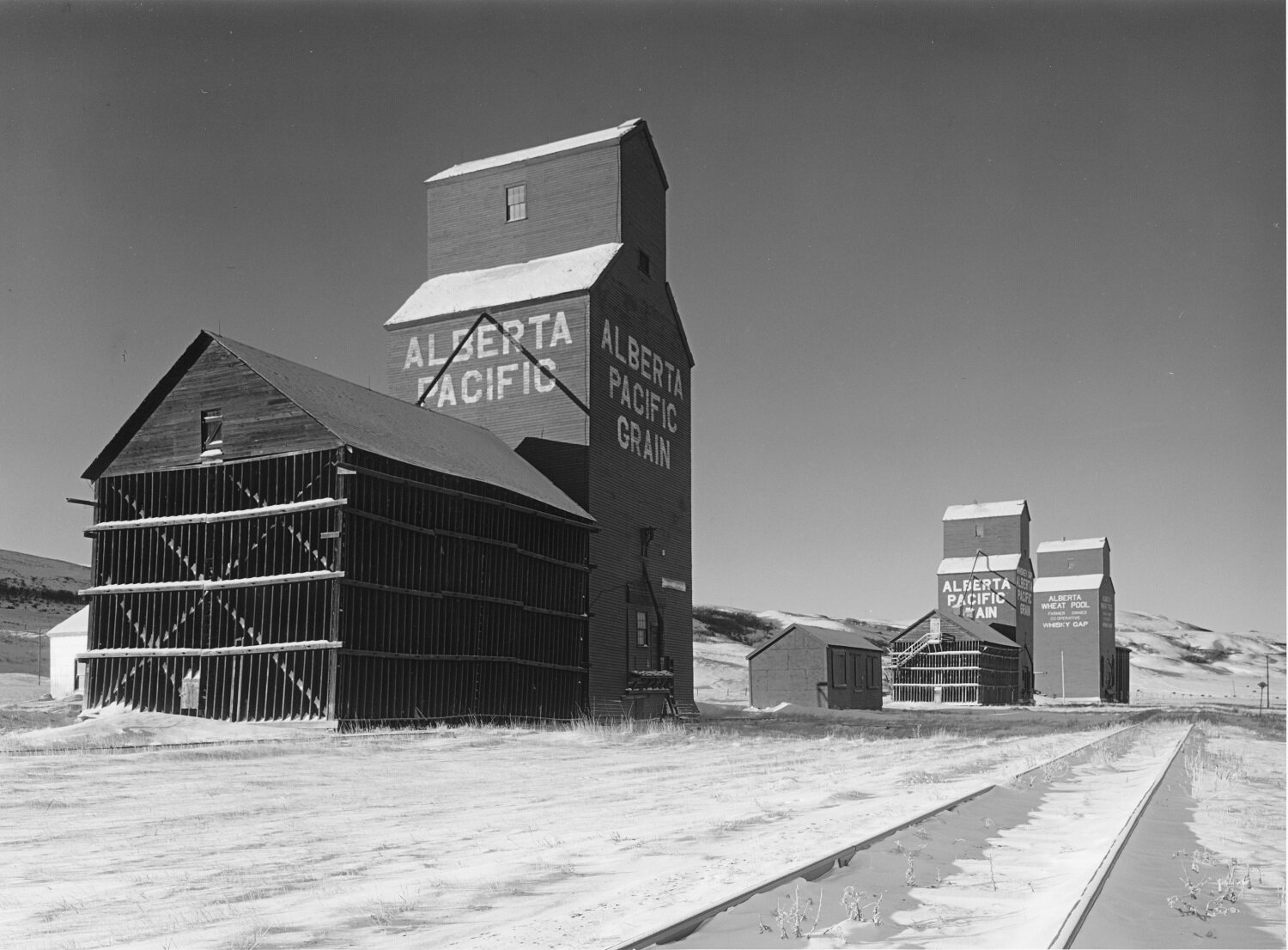
Whiskey Gap, Alberta, 1974, dark-room based selenium toned silver emulsion black & white photograph, framed, 11 x 14 inches (category D).
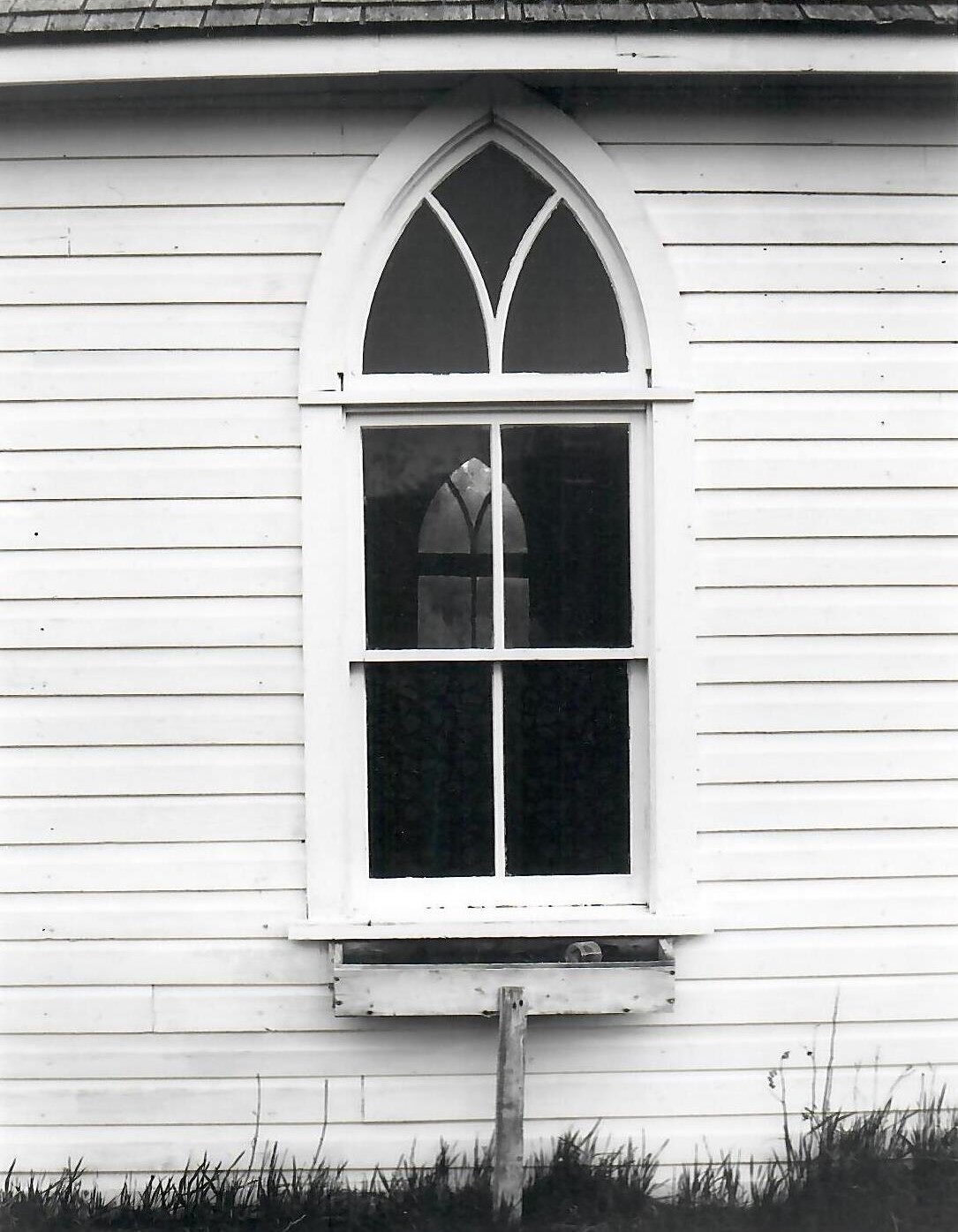
Church Window, South of Pincher Creek, c.1975, dark-room based selenium toned silver emulsion black & white photograph, framed, 4.5 x 3.5 inches (category A).
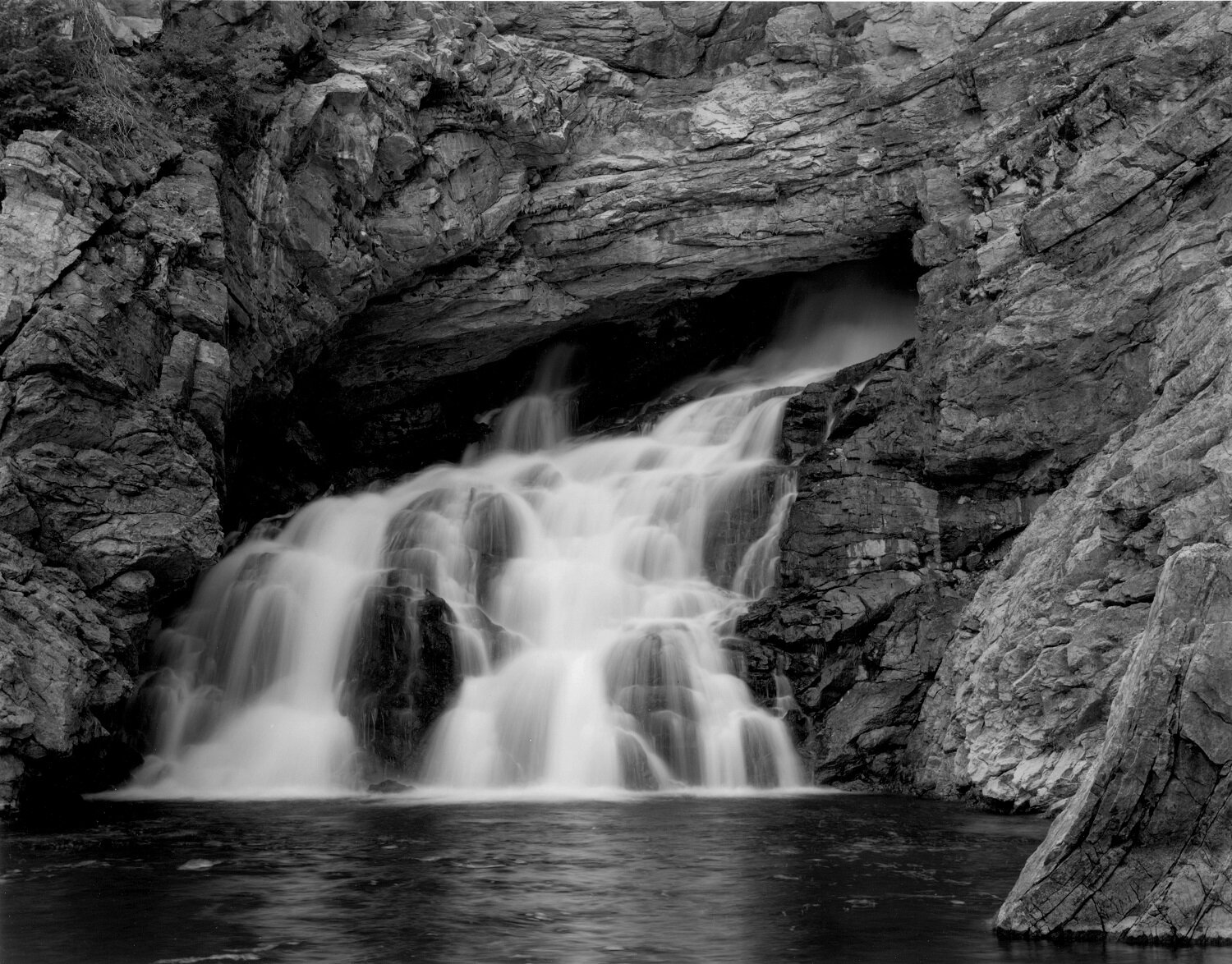
Running Eagle Falls, Glacier National Park, 2002, dark-room based selenium toned silver emulsion black & white photograph
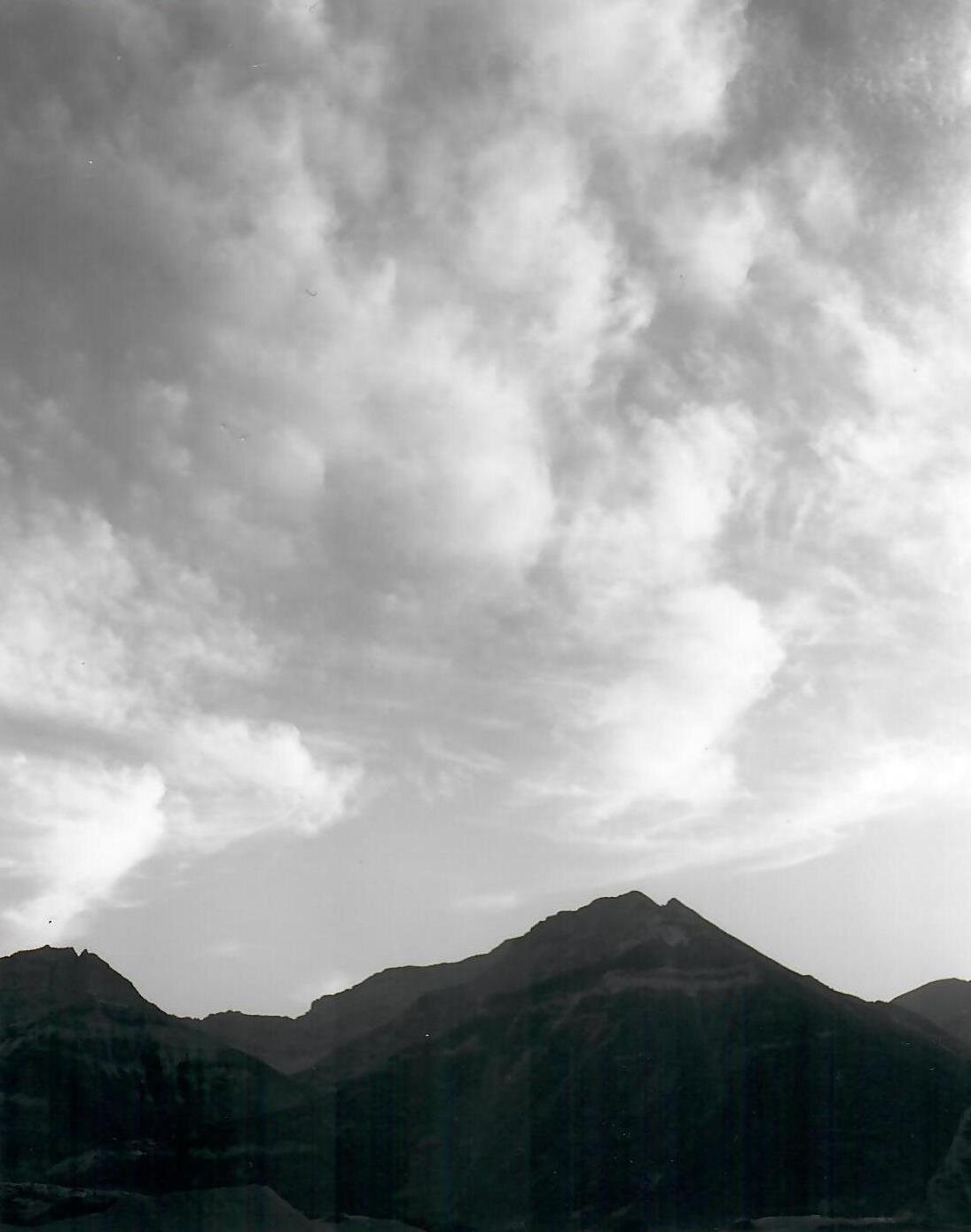
Mountain Sunset, Waterton, c.1984, dark-room based selenium toned silver emulsion black & white photograph, framed, 4.5 x 3.5 inches (category A).

Mountain Goats, High Line Trail, Glacier/Waterton, 1973, dark-room based selenium toned silver emulsion black & white photograph, framed, 8 x 10 inches (category C).

New Dayton Cafe, 1976, dark-room based selenium toned silver emulsion black & white photograph, framed, 3.25 x 4.25 inches (category A).
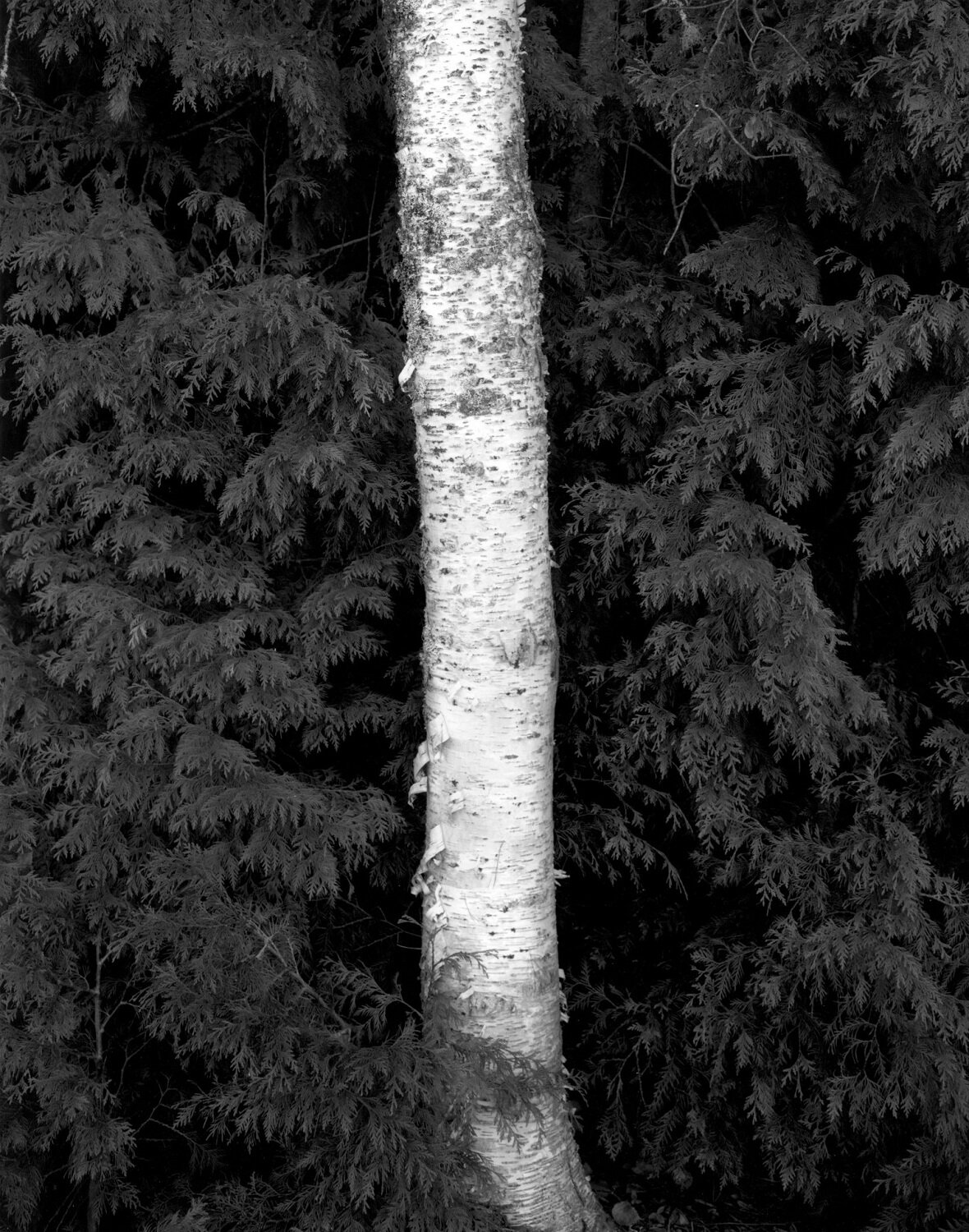
Birch and Cedars, Glacier National Park, 2003, dark-room based selenium toned silver emulsion black & white photograph, framed, 14 x 11 inches (category D).
- Episode 25 is gallery artist: Tom Willock ---------- LANDSCAPE AS MUSE SEASON II Full Season - $44.99 Cdn (13 episodes at 30 minutes each, episodes 14 through 26) - Episode 14 is our gallery artist: Jane Isakson - Episode 18 is our gallery artist: Douglas Haynes - Episode 26 is gallery artist: Peter von Tiesenhausen

Rundle from Vermilion, Banff (cat.#132), 1997, dark-room based selenium toned silver emulsion black & white photograph (sold out).

Alpine Larch, Waterton Lakes National Park (cat#126), c.1973, dark-room based selenium toned silver emulsion black & white photograph.
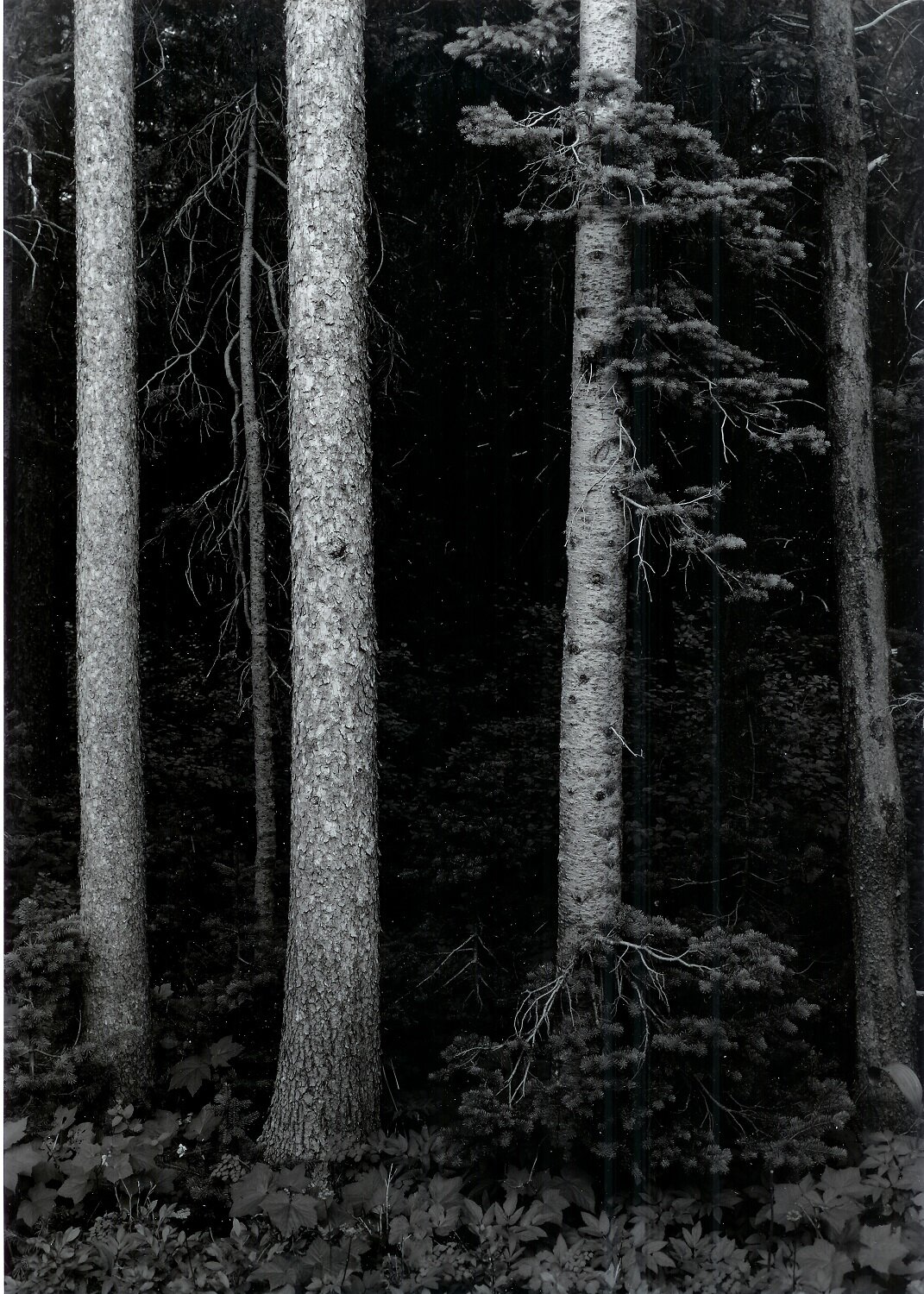
Pine Forest, Mount Carthew, Waterton (cat#31), 1984, dark-room based selenium toned silver emulsion black & white photograph.
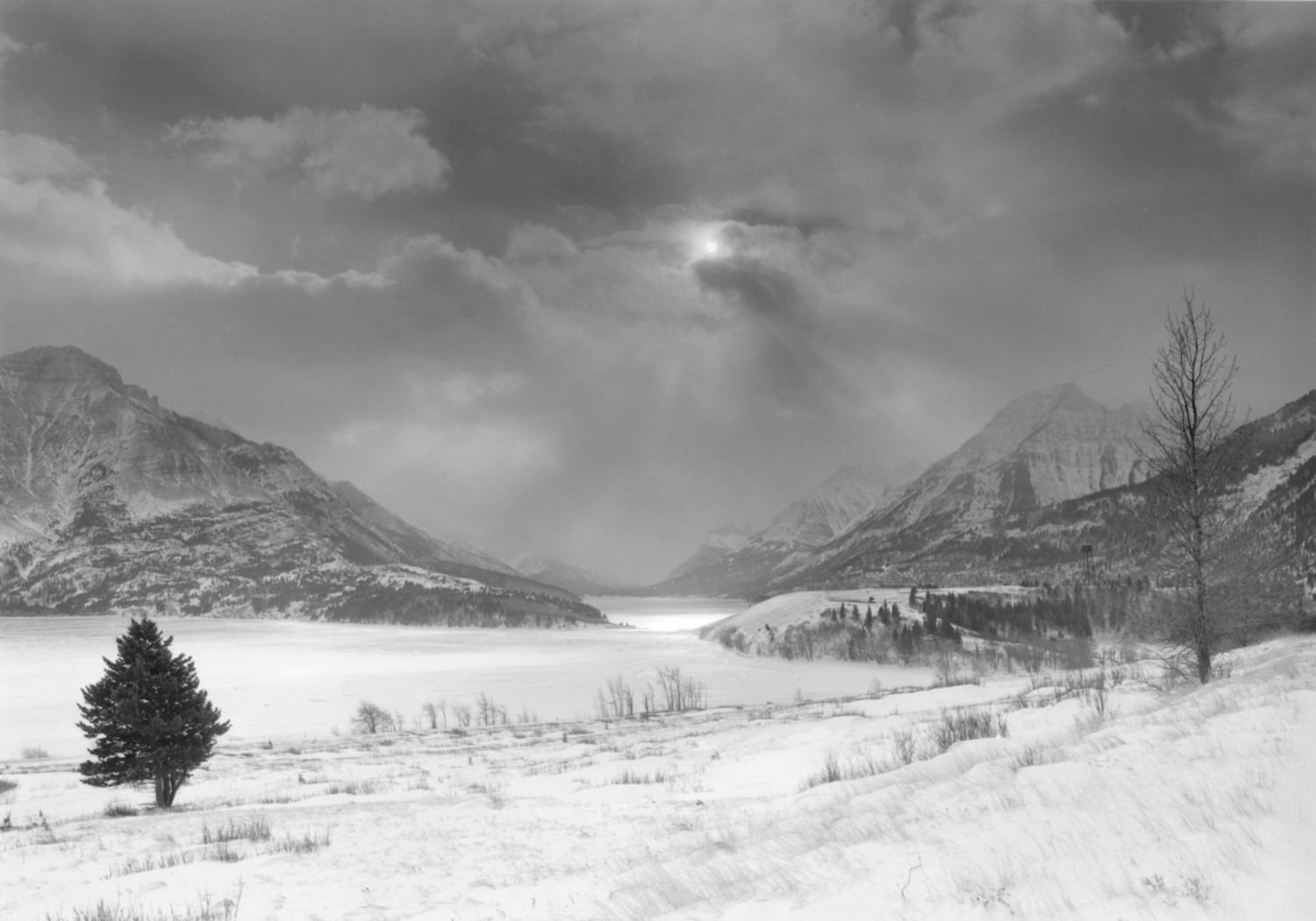
Waterton Winter Day (cat#69), 2000, dark-room based selenium toned black and white photograph.
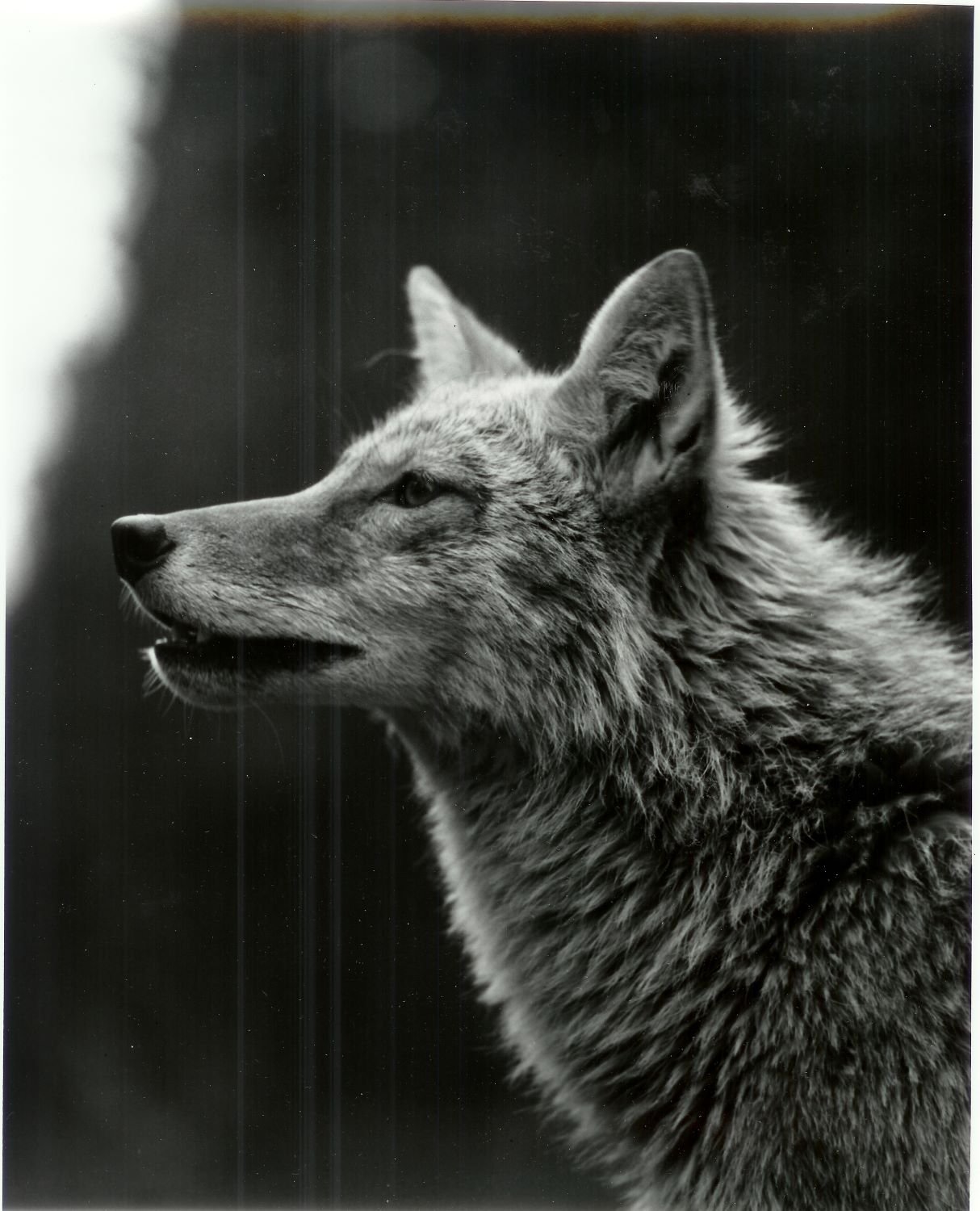
Coyote (cat#110), dark-room based selenium toned silver emulsion black and white photograph.

Fox Pup #2 (cat#41), 1972, dark-room based selenium toned silver emulsion black & white photograph, sold out.
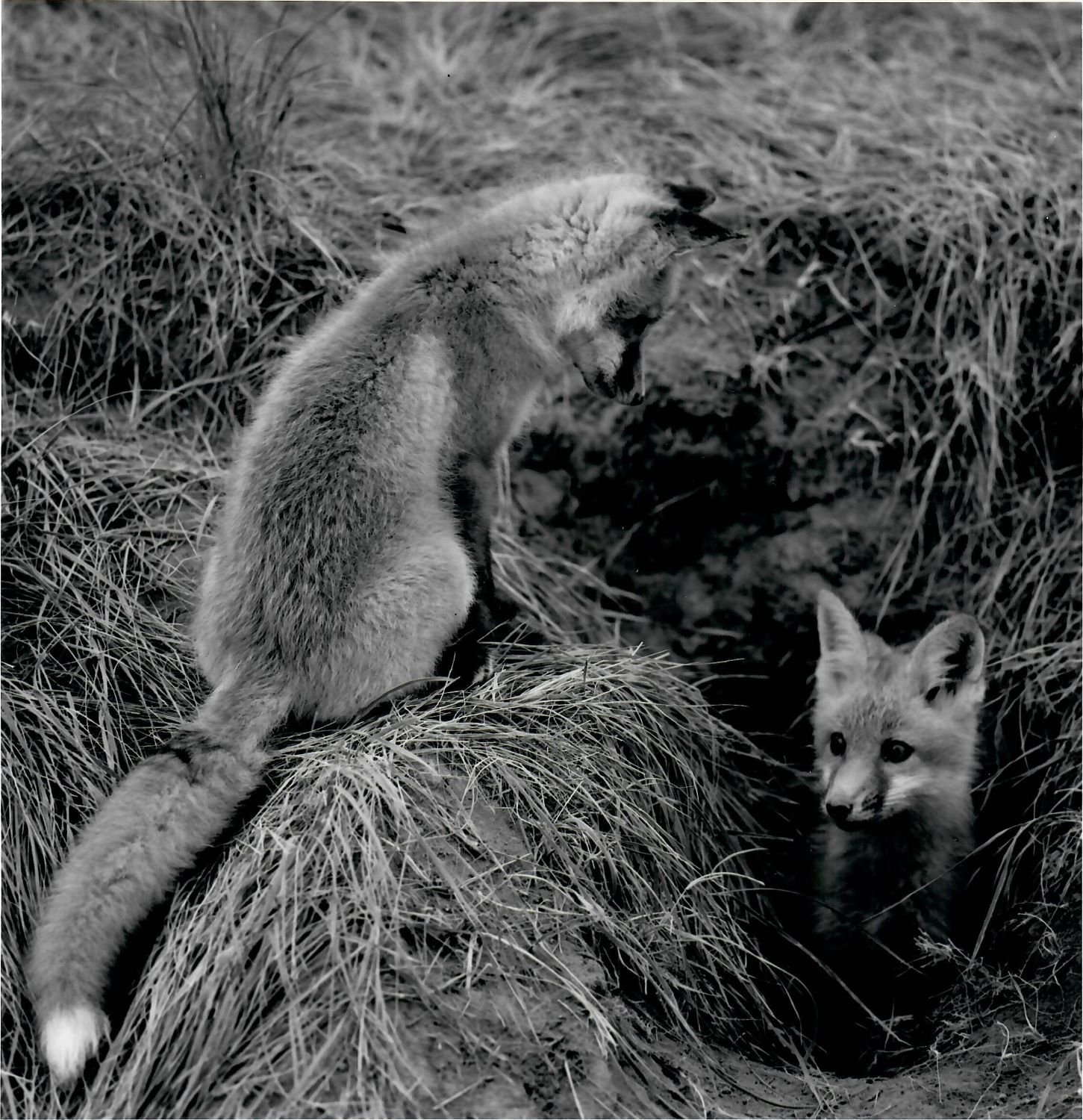
Red Fox Pups (Vulpes Fulva) (cat#41A), 1974, dark-room based selenium toned silver emulsion black & white photograph, sold out.

Bison Bull: Buffalo Paddock, Waterton (cat#74), 1971, dark-room based selenium toned silver emulsion black & white photograph, sold out.
Price Categories
A - $300 Cdn (3.5 x 4.5 inches / 9 x 11.5 cm)
B - $400 Cdn (5 x 7 inches / 13 x 18 cm)
C - $625 Cdn (8 x 10 inches / 20.5 x 25.5 cm)
D - $825 Cdn (11 x 14 inches / 28 x 35.5 cm)
E - $2200 Cdn (16 x 20 inches / 40.5 x 51 cm)
F - $3200 Cdn (20 x 24 inches / 51 x 61 cm)
G - $1100 Cdn (contact print 5 x 7 inches / 13 x 18 cm)
H - $4100 Cdn (diptych) - 2 x 16x20 inches / 40.5 x 51 cm)
N/A - (Portfolio #1, Elements of Wilderness, set of 12 unframed, mounted, 16 x 20 inch (40.5 x 51 cm) prints in archival solander box, edition 110)
N/A - (Portfolio Medicine Hat), set of 15 unframed, mounted, 8x10 inch (20.5 x 25.5 cm) prints in archival solander box, edition 110)
“We are all visitors, some simply stay longer than others.”
He has a persistent awareness that he owes a responsibility to place and a need to put form to that insight, hoping to strike a chord in others, to share an understanding or a passion.
An aluminium version of Trail of the Cedars is now part of Banff’s Art In Nature Trail.
In the 1950s, a Kodak Brownie Bull’s-Eye was Tom’s first camera, which extended his view of his hometown of Milk River, Alberta and initiated a lifelong love of photography. At the University of Alberta, in the early 1960s, he utilized a Pentax on such projects as Blue Grouse Behaviour, assisting Stu MacDonald (Stewart D. MacDonald 1927-2010, Curator of Vertebrate Ethology at the National Museum of Natural Sciences). At this time, Tom began developing his own black and white film. Graduate school at Carlton University and his job at the National Museum of Natural Sciences (both in Ottawa) brought more opportunities and more cameras. Returning to Alberta, he deepened his explorations as well as refined his darkroom technique, becoming a devoted advocate of the zone system pioneered by Ansel Adams. Tom attended workshops in California by John Sexton, a former assistant to Ansel Adams and by Freeman Patterson in New Brunswick. Sixty years later there is an impressive and extensive body of work, in colour and in darkroom-based selenium toned silver emulsion black and white photographs.
Exhibition October 2023 to January 2024 at the Whyte Museum of the Canadian Rockies.
2025 - Legacy by Tom Willock, Miller Gallery (Roxy Theatre), Edmonton.
Upcoming Exhibitions:
at Esplanade, Medicine Hat in 2027.
Tom’s cameras included working with a Linhof, Crown Graphic, Deardorff, Sinar-P, Toyo Field and Hasselblad cameras (to name a few). His work reveals his interest in telling a story of how each of us participates in the historical unfolding of places and lives – human, animal, plant, geological, and geographical. His consideration of their interconnectedness underlies his inspiration. Tom’s desire is to provide something, whether a thought or an image, that touches a key to the karma, the spirit, and the destiny of place.
Tom’s photographs are as constructed as the traditional film medium will allow. Each begins as an interaction with the landscape, sometimes scattered over many months or years. It proceeds to the development of an image; the composition, the timing and technique, the darkroom process, all translate the perspective, the idea. For Tom the best expression, the best story, is the perfect marriage of idea and craft.
A graduate of the University of Alberta (BSc) and Carleton University, Ottawa (MSc), Tom began his career in natural history and photography at the National Museum of Natural Sciences, Ottawa (1968-70). As a consultant, he conducted Wildlife Impact Studies (1970-6). At the Lethbridge Community College Tom was a Sessional Instructor in Wildlands Conservation (1971-3) and the Technician for the Dept. of Biological Sciences (1976-8) at the University of Lethbridge. As a natural history photojournalist his landscape and wildlife photographs along with his commercial portrait, aerial, and industrial photography have been widely published in both Europe and North America. Tom is author of the natural history book A Prairie Coulee (Lone Pine Press, 1991) and has written numerous articles and given talks on museums, photography, and natural history.

